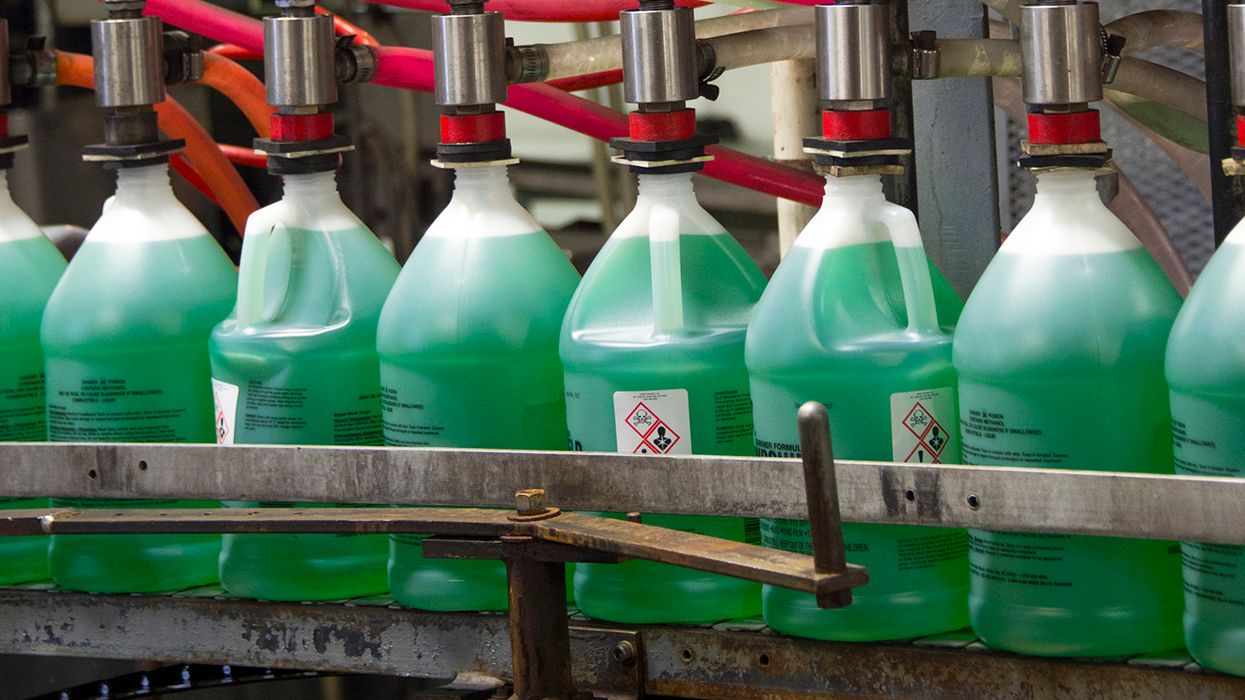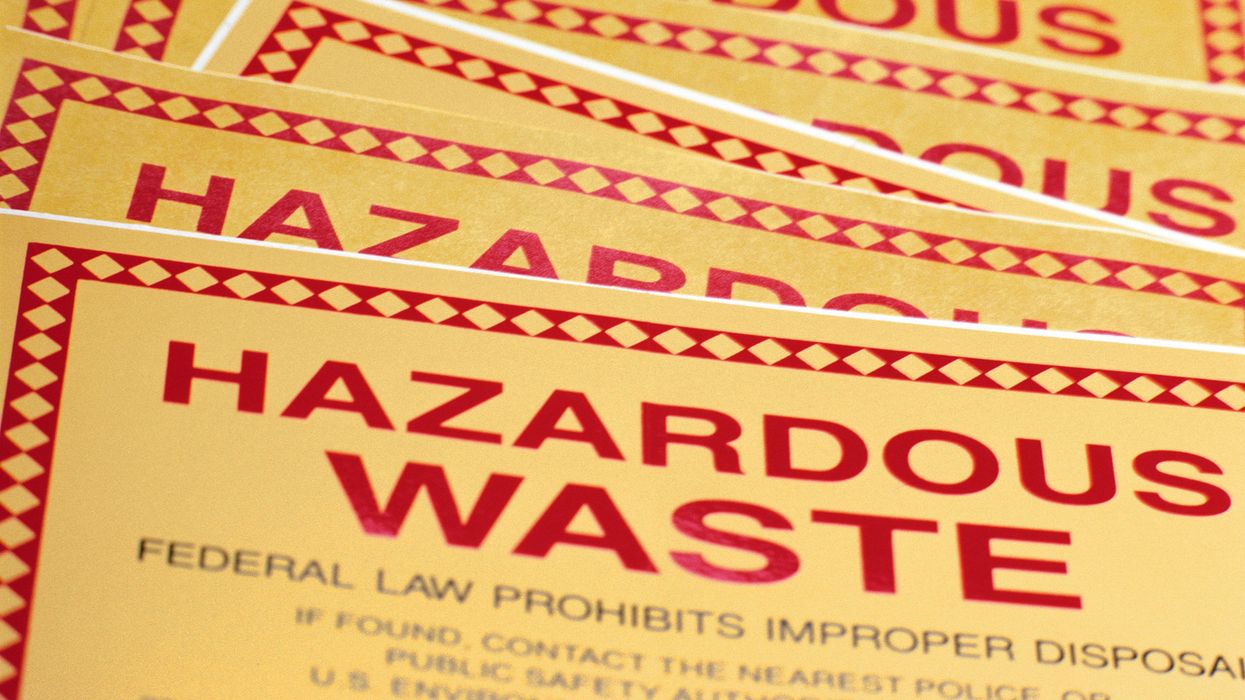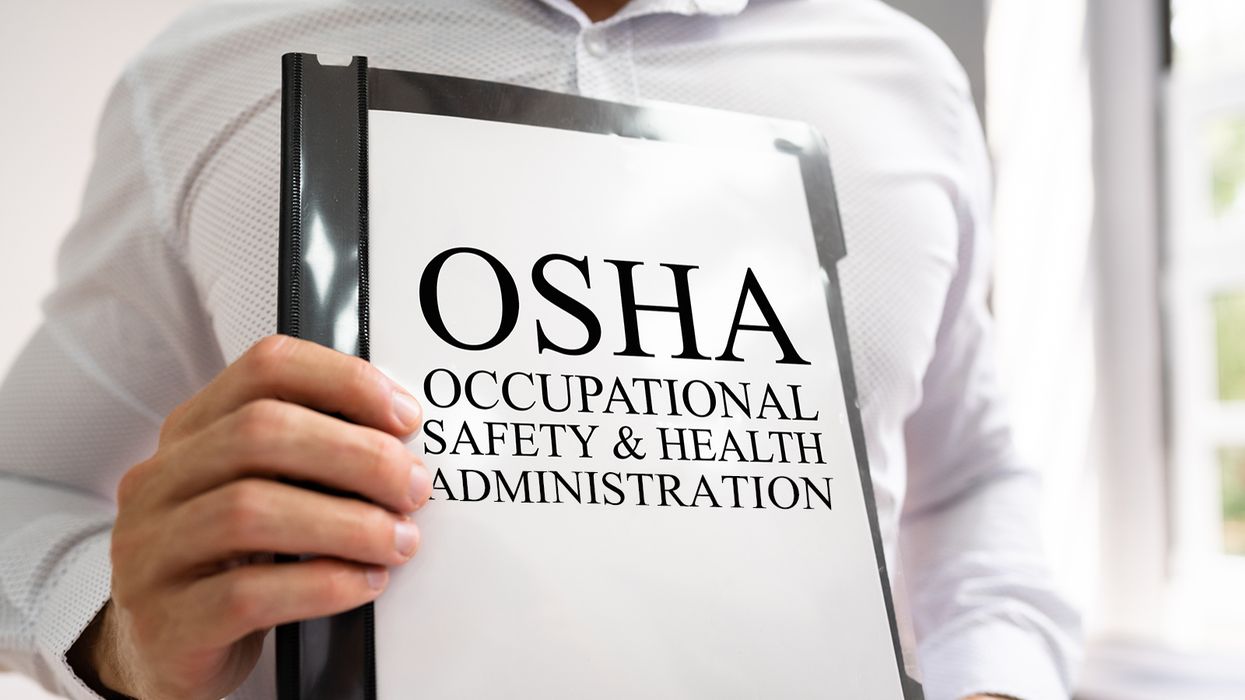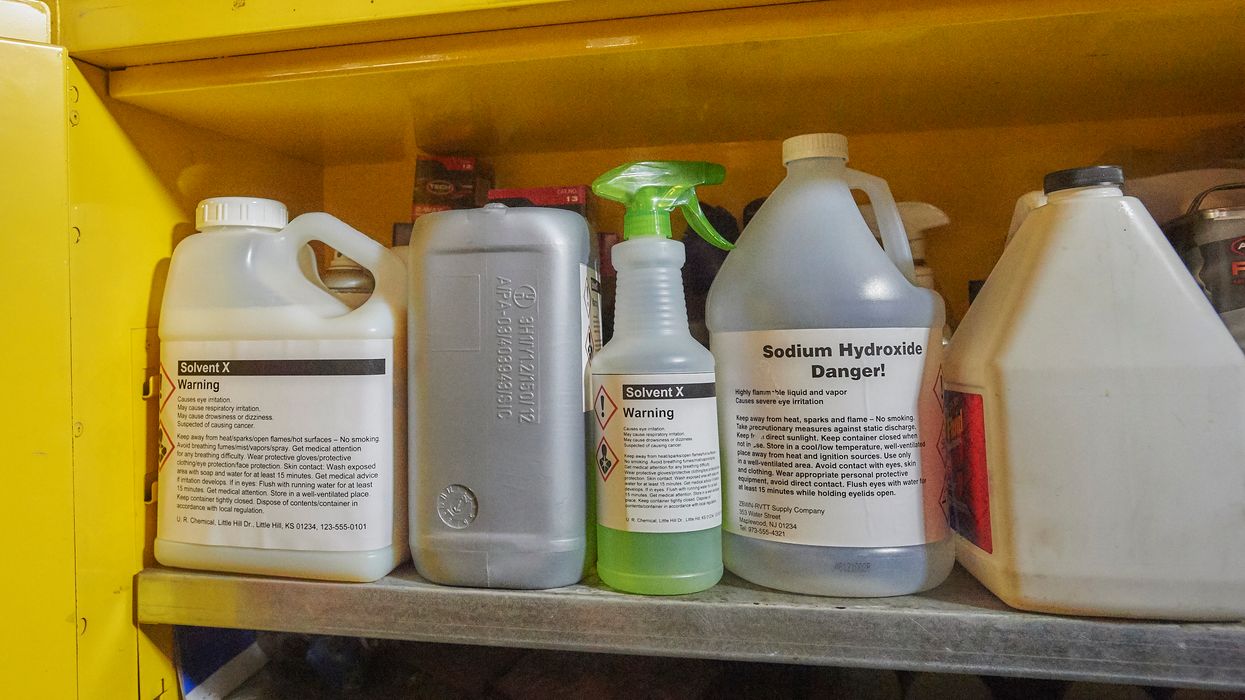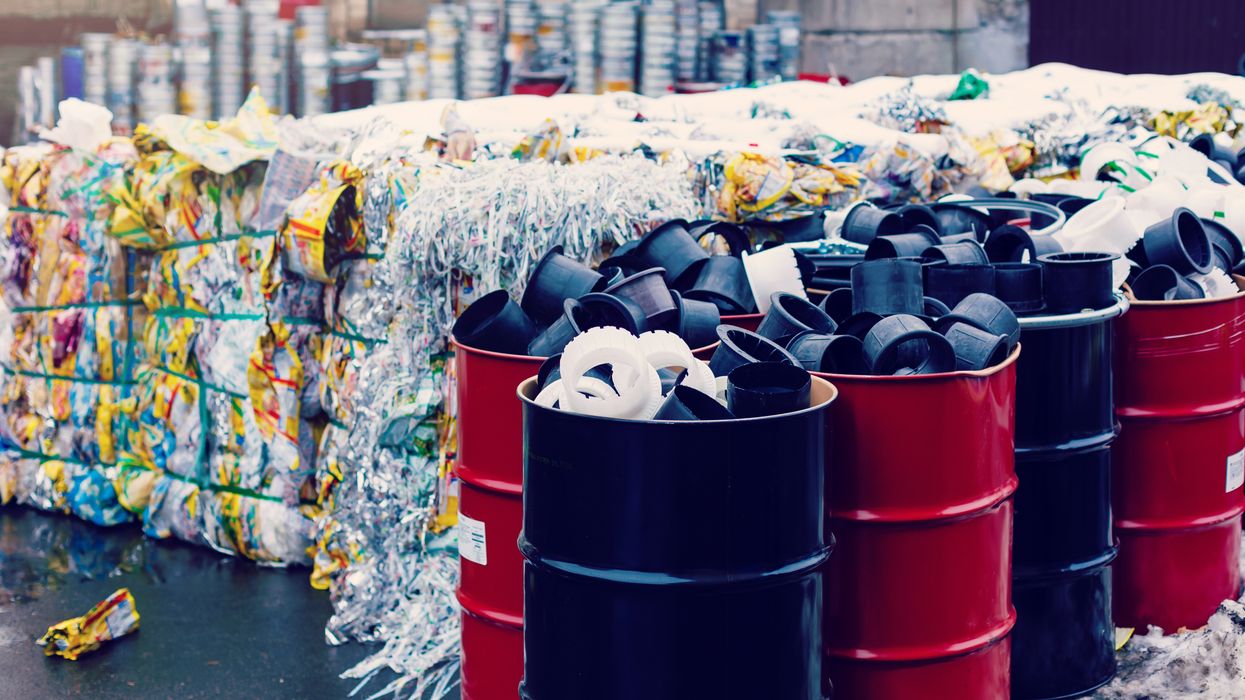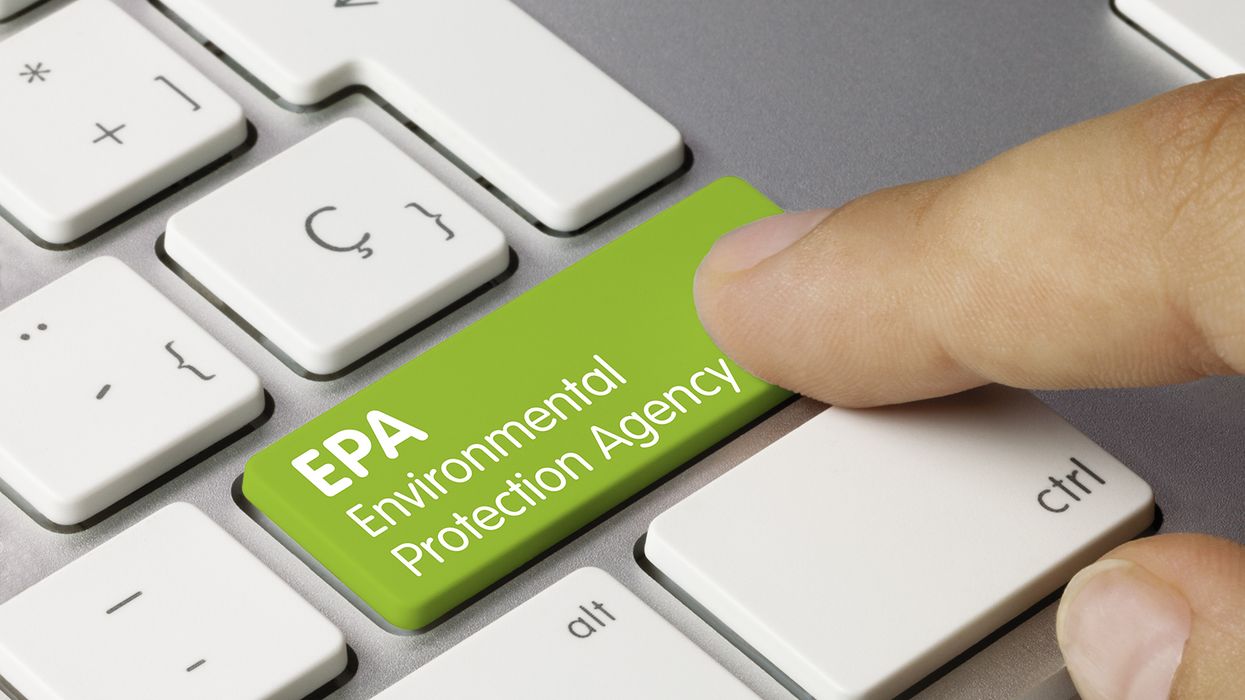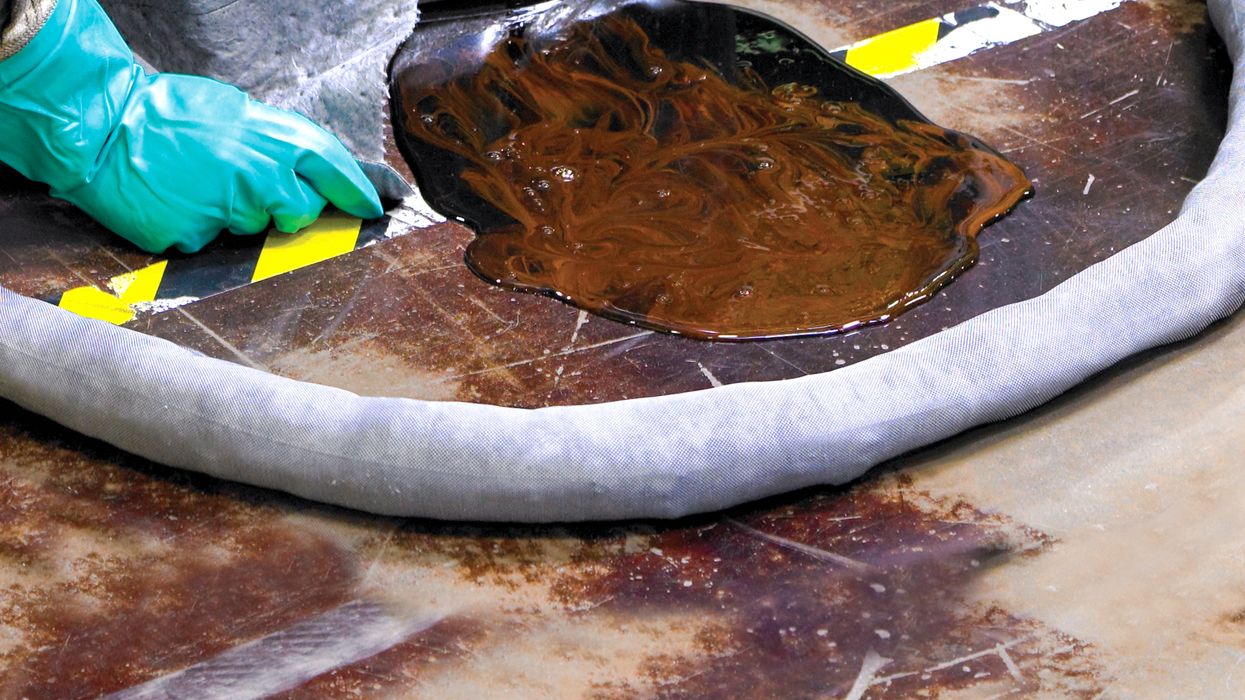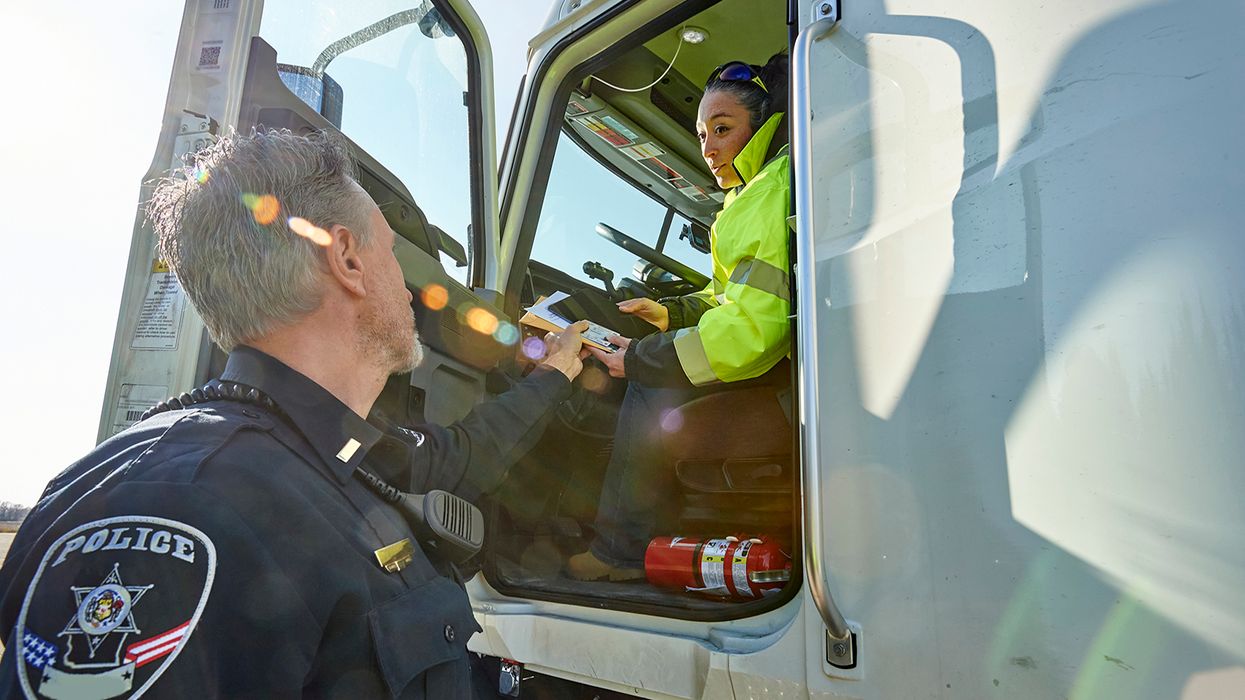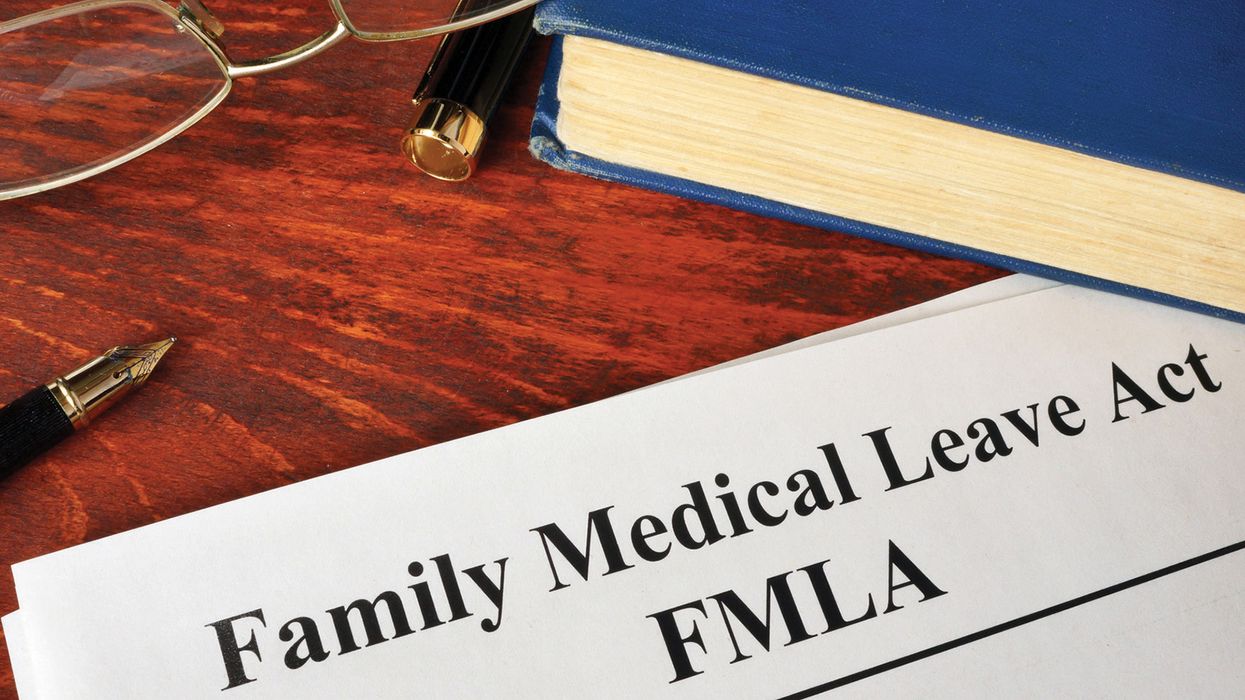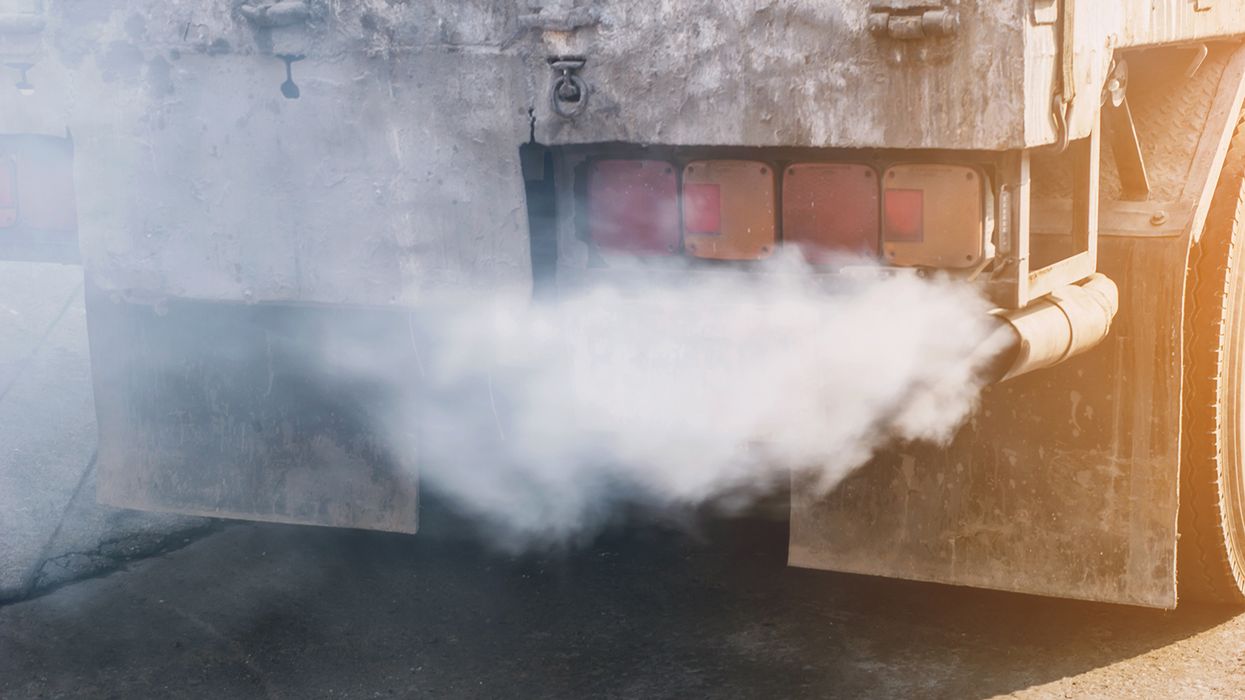This is a test site update for Compliance Network.
[]
[]
2022-04-12T05:00:00Z
JOIN TODAY TO CONTINUE READING THIS ARTICLE & OTHER INDUSTRY NEWS!
You'll also get exclusive access to:
A database of easy-to-understand regulationsAsk unlimited questions to our expertsPre-led discussions forumsAnd more
TRY IT FREE TODAY
Already have an account? Log in now.
This is a test site update for Compliance Network.
See More
RELATED NEWS

Specialized Industries
Go beyond the regulations! Visit the Institute for in-depth guidance on a wide range of compliance subjects in safety and health, transportation, environment, and human resources.
J. J. Keller® COMPLIANCE NETWORK is a premier online safety and compliance community, offering members exclusive access to timely regulatory content in workplace safety (OSHA), transportation (DOT), environment (EPA), and human resources (DOL).

Interact With Our Compliance Experts
Puzzled by a regulatory question or issue? Let our renowned experts provide the answers and get your business on track to full compliance!

Upcoming Events
Reference the Compliance Network Safety Calendar to keep track of upcoming safety and compliance events. Browse by industry or search by keyword to see relevant dates and observances, including national safety months, compliance deadlines, and more.
SAFETY & COMPLIANCE NEWS
Keep up with the latest regulatory developments from OSHA, DOT, EPA, DOL, and more.
REGSENSE® REGULATORY REFERENCE
Explore a comprehensive database of word-for-word regulations on a wide range of compliance topics, with simplified explanations and best practices advice from our experts.
THE J. J. KELLER INSTITUTE
The Institute is your destination for in-depth content on 120+ compliance subjects. Discover articles, videos, and interactive exercises that will strengthen your understanding of regulatory concepts relevant to your business.
ADD HAZMAT, ENVIRONMENTAL, & HR RESOURCES
Unlock exclusive content offering expert insights into hazmat, environmental, and human resources compliance with a COMPLIANCE NETWORK EDGE membership.
DIRECT ACCESS TO COMPLIANCE EXPERTS
Struggling with a compliance challenge? Get the solution from our in-house team of experts! You can submit a question to our experts by email, set up a phone or video call, or request a detailed research report.
EVENTS
Register to attend live online events hosted by our experts. These webcasts and virtual conferences feature engaging discussions on important compliance topics in a casual, knowledge-sharing environment.
Most Recent Highlights In Environmental
NewsGreenhouse GasesIndustry NewsEnvironmental Protection Agency (EPA)CAA ComplianceEnvironmentalIn-Depth ArticleFocus AreaEnglishAir ProgramsAir ProgramsUSA
2025-11-25T06:00:00Z
Annual HFC report: First submissions due March 2026
What do the manufacturers of hairspray cans, foam wall insulation, and ice cream machines have in common? If their products contain hydrofluorocarbons (HFCs), they have to report annually on the HFCs they use, and the first report due date is quickly approaching! Through the Technology Transitions Program, the Environmental Protection Agency (EPA) regulates HFCs used for new products and equipment in three sectors: aerosols, foams, and refrigeration, air conditioning, and heat pumps (RACHP). Among other compliance requirements of the 2023 Technology Transitions Rule, manufacturers and importers of HFC-containing products and equipment must submit annual reports.
Note: EPA’s October 2025 proposed rule to amend the 2023 Technology Transitions Rule doesn’t impact annual reporting requirements.
Use this overview to help you determine whether your business needs to report and, if so, what’s required.
Who reports?
Annual reporting applies to manufacturers and importers of products and equipment that use HFCs. An organization has to submit an annual report if:
- It manufactures or imports a product or component within a regulated sector or subsector (see 40 CFR 84.54), and
- The product or component uses or will use a regulated HFC or HFC blend.
Reporting requirements apply to manufacturers and importers in all sectors and subsectors, and they start with data from calendar year 2025. The first annual report is due to EPA by March 31, 2026.
Note that the annual reporting requirements don’t apply to entities that only:
- Sell or distribute equipment, or
- Install or operate new RACHP systems.
What’s reported?
In each annual report, covered manufacturers and importers must provide:
- The entity’s name and address;
- The entity’s contact person, email address, and phone number;
- The calendar year covered by the report and the submission date;
- All applicable North American Industry Classification System (NAICS) codes; and
- A statement certifying that the data is accurate and that the products use HFCs or HFC blends in compliance with the use restrictions and labeling requirements.
Entities in all three sectors also have to report the total mass in metric tons of each HFC or HFC blend contained in all products and components manufactured, imported, and exported annually.
Further, sector-specific standards apply.
| Sector | Requires additional information for: | See 40 CFR: |
|---|---|---|
| Aerosol | 84.60(a)(5) | |
| Foam |
| 84.60(a)(4) |
| RACHP |
| 84.60(a)(3) |
How’s the report submitted?
According to the latest information shared by EPA in the “Technology Transitions Program: What You Need to Know for January 1, 2025” webinar presentation, the agency is still designing the electronic platform for submitting annual reports. EPA plans to provide reporting instructions and forms before the upcoming deadline.
About the 2023 Technology Transitions Rule
HFCs are greenhouse gases that were developed to replace ozone-depleting substances for use in various products and equipment (primarily refrigeration and air-conditioning systems). The American Innovation and Manufacturing Act of 2020 gives EPA the authority to address HFCs by:
- Phasing down production and consumption through the HFC Allowance Allocation Program,
- Implementing restrictions on HFC use in specific sectors, and
- Developing regulations to maximize the reclamation and minimize the release of HFCs from equipment.
The 2023 Technology Transition Rule established the Technology Transitions Program to restrict HFC uses in sectors and subsectors where lower global warming potential (GWP) technologies are or will soon be available. The regulations apply to manufacturers (including importers), exporters, sellers, distributors, and installers of systems or products in covered sectors that use HFCs.
What about the proposed changes to the 2023 Technology Transitions Rule?
On October 3, 2025, EPA proposed a rule to amend the existing 2023 Technology Transition Rule. However, the proposed changes don’t affect the annual reporting requirements for manufacturers and importers. All covered manufacturers and importers must submit the annual report by March 31, 2026.
The proposed rule impacts specific subsectors, including refrigerated transport, industrial process refrigeration, chillers, retail food (for supermarkets and remote condensing units), cold storage warehouses, and stationary residential and light commercial air conditioning and heat pumps. EPA proposes to:
- Exempt certain intermodal containers transporting cargo at very cold temperatures;
- Extend compliance dates for industrial process refrigeration used in semiconductor manufacturing;
- Raise global warming potential thresholds for remote condensing units, supermarket systems, and cold storage warehouses;
- Extend compliance dates for refrigerated centrifuges and laboratory shakers; and
- Allow existing residential and light commercial air-conditioning and heat pump equipment (i.e., manufactured or imported before January 1, 2025) to continue to be installed.
Key to remember: The first annual reports required by the Technology Transitions Program for manufacturers and importers of HFC-containing products and equipment are due by March 31, 2026.
NewsCERCLA, SARA, EPCRASafety Data Sheet ReportingIn-Depth ArticleHazard CommunicationEnglishTier II Inventory ReportingSafety Data SheetsIndustry NewsSafety & HealthConstruction SafetyGeneral Industry SafetyAgriculture SafetyMaritime SafetyEnvironmentalHazard CommunicationSARA ComplianceFocus AreaUSA
2025-11-25T06:00:00Z
EPA’s SDS/Tier II reporting now in lockstep with OSHA HazCom
EPA issued a direct final rule to update its safety data sheet (SDS) reporting and Tier II inventory reporting requirements. The changes align EPA 40 CFR 370 with OSHA’s Hazard Communication (HazCom) standard at 29 CFR 1910.1200.
The biggest change is that facilities will be able to copy the hazard categories directly from section 2 of the SDSs to their Tier II report forms. This eliminates the guesswork. However, facilities may face added strain with their first Tier II submission under the rule. Instead of relying on the grouped hazard categories selected in the previous year’s forms, it looks like facilities will need to spend extra time retrieving specific categories from their SDSs.
Who’s impacted by the rule?
EPA 40 CFR 370 applies to a facility owner or operator if:
- The OSHA HazCom standard requires the facility to prepare or have available an SDS or material safety data sheet (MSDS) for a hazardous chemical;
- The hazardous chemical is not exempted at 370.13 or 1910.1200(b)(6); and
- The hazardous chemical is present at or above certain threshold levels.
If the applicability criteria are met, the facility owner/operator must submit to the state emergency response commission (SERC), local emergency planning committee (LEPC), and local fire departments:
- An SDS or MSDS for each covered hazardous chemical or a list of all covered hazardous chemicals; and
- A Tier II hazardous chemical inventory form by March 1 annually for all covered hazardous chemicals.
A state may make its own laws and regulations in addition to or more stringent than federal Part 370.
What’s changing in Part 370?
Last year, OSHA amended its HazCom standard to conform to the seventh edition of the United Nations Globally Harmonized System of Classification and Labelling of Chemicals (GHS). Changes to the chemical hazard classifications and categories were part of the amendments to 1910.1200. This is important because EPA Part 370 relies on the OSHA HazCom standard for the definition of “hazardous chemical” and the hazard categories that must be reported.
In the latest rule published November 17, 2025, EPA takes several actions to harmonize its regulations with OSHA’s. The preamble offers a complete list of amendments to Part 370. Here’s a summary:
| Change: | Details: | Sections affected: |
| Adopts all 112 OSHA hazard categories |
| 370.3, 370.30, 370.41, and 370.42 |
| Updates terminology |
| 370.3 and 370.66 |
| Removes the term MSDS |
| 370.3, 370.10, 370.12, 370.13, 370.14, 370.20, 370.30, 370.31, 370.32, 370.33, 370.60, 370.62, 370.63, and 370.64 |
| Makes minor plain language, clarifying, and consistency corrections |
| 370.1, 370.2, 370.3, 370.10, 370.14, 370.30, 370.32, 370.33, 370.40, 370.41, 370.42, 370.43, 370.44, 370.45, 370.60, 370.61, 370.62, 370.64, 370.65, and 370.66 |
When will the changes take effect?
The direct final rule is effective January 16, 2026, unless EPA receives an adverse comment during its 30-day comment period. If that happens, the agency will publish a timely withdrawal. Then, it will move along with the proposed rule (also published in the November 17, 2025, Federal Register) and address public comments in a subsequent final rule.
Assuming no adverse comment is received on the original direct final rule, EPA gives covered facilities time to prepare. The rule offers a compliance date of December 1, 2026, for both SDS reporting and Tier II reporting. Note that for Tier II reporting, the updates kick in for the 2026 inventory reporting year, which impacts forms due by March 1, 2027, and thereafter. (Forms due on or before March 1, 2026, are unchanged.)
Key to remember
EPA took action to harmonize Part 370 with the changes OSHA made to 1910.1200 last year. The latest amendments to Part 370 have a compliance date of December 1, 2026. For Tier II reporting, the updates start with forms due on or before March 1, 2027.
NewsHazardous WasteIndustry NewsWaste GeneratorsWaste/HazWasteSatellite AccumulationWasteEnvironmentalIn-Depth ArticleEnglishFocus AreaUSA
2025-11-24T06:00:00Z
Avoiding costly mistakes: The most common RCRA hazardous waste violations
If your facility generates hazardous waste, compliance with the Resource Conservation and Recovery Act (RCRA) is not optional. Yet many businesses overlook key requirements, leading to violations that can cost thousands in fines and damage their reputation. Understanding the most common mistakes and how to prevent them can keep your operations safe and compliant.
The most frequent violations according to EPA
One of the most common errors is failing to determine whether a waste is hazardous. Businesses often assume leftover chemicals, contaminated rags, or spent filters are non-hazardous without testing or applying EPA criteria. Misclassification leads to improper storage and disposal, which can escalate into multiple violations.
Container management is another frequent problem. Inspectors often find containers without the required “Hazardous Waste” label or missing the accumulation start date. Some containers are left open or improperly sealed, allowing leaks or vapors to escape. These issues are easy to fix but often overlooked in busy facilities.
Weekly inspections are mandatory for central accumulation areas, yet many companies skip them or fail to document them correctly. Missing dates, signatures, or inspection logs can result in citations even if the area is otherwise compliant.
Employee training is another weak spot. Large Quantity Generators must train staff on handling hazardous waste and emergency procedures and keep records of that training. Training should be job specific including emergency response specific to the facility. When training is incomplete or undocumented, it counts as a violation even if employees know what to do.
Improper disposal is a serious and costly mistake. Pouring hazardous waste down drains, tossing it in regular trash, or shipping it without a manifest violates federal law. These actions can lead to severe penalties and, in some cases, criminal liability.
Other common issues include exceeding accumulation time limits, 90 days for large quantity generators and 180 days for small quantity generators, without obtaining a permit. Facilities also forget to maintain a valid EPA identification number or fail to update contingency plans and emergency contact information.
How to stay compliant
Start with a thorough waste determination. Identify all materials that could be hazardous and classify them correctly and keep a record of the waste determination. Review container labeling and make sure every container is closed, dated, and marked “Hazardous Waste.” Establish a routine for weekly inspections and keep detailed records.
Invest in employee training and refresh it regularly. Document every session and keep those records accessible. Monitor accumulation times and set reminders to move waste before deadlines. Always use the Uniform Hazardous Waste Manifest when shipping waste off-site, and verify that your transporter and disposal facility are authorized.
Finally, maintain your EPA site ID number and update your contingency plan. Make sure emergency equipment is available, and local responders have your contact information.
Key to Remember: RCRA compliance is detailed, but most violations stem from simple oversights such as open containers, missing labels, skipped inspections, or forgotten paperwork. By building strong procedures and training your team, you can avoid costly mistakes and keep your facility safe and compliant.
NewsIndustry NewsEnglishEMS Audits and EvaluationsEnvironmental Management SystemsEnvironmentalIn-Depth ArticleUSAEnvironmental Management SystemsFocus AreaEnvironmental Management Systems
2025-11-21T06:00:00Z
Expert Insights: Connecting environmental compliance and employee safety
Environmental compliance and workplace safety are often treated as separate priorities, but they’re deeply connected. A strong environmental compliance program doesn’t just protect the environment; it also significantly improves safety outcomes, reduces risks, and safeguards employees.
Why environmental compliance matters for safety
Environmental compliance means following laws and regulations designed to prevent pollution and protect natural resources. These rules often overlap with occupational safety standards because environmental hazards such as chemical spills, air emissions, and improper waste handling can directly harm workers.
For example:
- Chemical spills can create slippery surfaces, leading to falls and injuries.
- Air emissions from volatile chemicals can cause respiratory illnesses or even explosions if vapors accumulate.
- Improper waste storage can result in fires or toxic exposure.
The Environmental Protection Agency (EPA) focuses on preventing environmental contamination, while the Occupational Safety and Health Administration (OSHA) ensures safe working conditions. Ignoring environmental requirements can lead to unsafe conditions like toxic exposure, fire hazards, and respiratory risks.
How tracking spills reduced slips
A few years ago, I worked with a manufacturing facility that had recurring slip incidents near the chemical storage area. Initially, they were treated as isolated safety issues. The facility added cautionary signs, but the problem persisted.
After talking with the safety officer, I noticed a pattern. Since these near-miss spills occur inside a building, they typically aren’t reportable from an environmental compliance standpoint. These small drips during drum transfers or hose disconnections weren’t classified as “spills” by operators, so they weren’t cleaned up immediately.
The facility implemented a new process. Every chemical drip or near-miss spill had to be logged and addressed as part of both environmental and safety compliance. Absorbent mats were added near transfer stations, drip trays were installed under valves, and employees were trained to report even minor leaks and spills.
Within 3 months, slip incidents dropped significantly. By integrating spill tracking into the safety program, they not only reduced injuries but also improved their EPA audit scores. This new process of tracking near-miss spills also proved to be a good leading indicator. The facility discovered trends in equipment maintenance and had a more complete picture of the cost of releases.
The business case for integration
Integrating environmental compliance into safety programs offers several advantages:
- Reduced risk of incidents: Compliance minimizes hazards that could harm employees and the environment.
- Regulatory collaboration: Many safety and environmental requirements overlap, allowing for streamlined processes.
- Enhanced reputation: Demonstrating commitment to both safety and sustainability builds trust with regulators, customers, and the community.
- Cost savings: Preventing spills, fires, and injuries avoids costly fines, cleanup expenses, and workers’ compensation claims.
To maximize the impact of environmental compliance on safety programs, industrial facilities should consider the following:
- Joint audits: Evaluate environmental and safety risks together to identify overlapping controls.
- Holistic employee training: Include environmental compliance topics in safety training sessions and toolbox talks (and vice versa).
- Integrated procedures: Develop standard operating procedures that address both environmental and safety requirements.
- Technology: Implement monitoring systems for air quality, spill detection, and waste tracking.
Environmental compliance is a key driver of workplace safety. By integrating both programs, facilities can protect employees and the environment at the same time.
NewsIndustry NewsEnglishEnvironmental Management SystemsEnvironmentalIn-Depth ArticleUSAEnvironmental Management SystemsFocus AreaEnvironmental Management Systems
2025-11-18T06:00:00Z
Navigating the complexities of multi-jurisdictional environmental compliance
Companies operating across multiple states, or internationally, face a growing challenge: staying compliant with a patchwork of environmental regulations. As federal agencies scale back certain environmental rules, states are stepping in to fill the gaps. But these state-level regulations aren’t always aligned. One state may impose strict air quality standards, while another may prioritize water discharge limits. This fragmented landscape creates a complex web of requirements that businesses must navigate to avoid fines, delays, or reputational harm.
The compliance puzzle: Federal, state, and global layers
In the U.S., environmental laws are enforced at both federal and state levels. While EPA sets national standards, states often go further. For example:
- California requires Scope 3 greenhouse gas emissions reporting for large companies starting in 2027.
- New York and Vermont have enacted climate superfund laws that hold fossil fuel companies financially liable for climate-related damages.
- Louisiana successfully challenged the EPA’s use of environmental justice criteria in permitting decisions, resulting in a federal court ruling that blocks Title VI enforcement in the state.
Internationally, U.S. companies face additional hurdles. The European Union’s Corporate Sustainability Due Diligence Directive (CSDDD) requires companies to identify and mitigate environmental risks across their global supply chains. This means a U.S. firm with operations or suppliers in Europe must meet stricter standards, even if those standards differ from U.S. law.
Environmental Management Systems (EMS): A strategic solution
To manage this complexity, many companies adopt Environmental Management Systems such as ISO 14001. An EMS provides a structured framework to:
- Identify applicable regulations across jurisdictions,
- Set environmental goals and track performance,
- Conduct internal audits and drive continual improvement, and
- Ensure consistent documentation and training.
EMS tools help companies centralize oversight, reduce compliance gaps, and respond quickly to regulatory changes. For example, a company using EMS software can assign location-specific tasks, monitor progress, and generate reports tailored to each jurisdiction’s requirements.
Practical strategies for multi-jurisdictional success
- Centralize compliance oversight: Use a unified system to track permits, deadlines, and reporting across all sites.
- Leverage EMS tools: Automate alerts, audits, and documentation to stay ahead of changes.
- Train staff by location: Tailor training to reflect the specific rules and risks of each jurisdiction.
- Conduct routine audits: Internal reviews help catch issues before regulators do.
Key to Remember: Multi-jurisdictional compliance isn’t just about knowing the rules—it’s about building systems that adapt to them. An Environmental Management System, paired with proactive planning and location-specific training, helps companies stay compliant, reduce risk, and operate confidently across borders.
Most Recent Highlights In Transportation
NewsTier II Inventory ReportingCERCLA, SARA, EPCRA CERCLA, SARA, EPCRASARA ComplianceCommunity Right to KnowChange NoticesChange NoticeEnvironmental Protection Agency (EPA)EnvironmentalEnglishSARA ComplianceFocus AreaUSA
2025-11-17T06:00:00Z
EPA Final Rule: Technical Amendments to the EPCRA Hazardous Chemical Inventory Reporting Requirements To Conform to the 2024 OSHA Hazard Communication Standard
The Environmental Protection Agency is taking direct final action to conform the Emergency Planning and Community Right-to-Know Act hazardous chemical inventory reporting regulations to the Occupational Safety and Health Administration's Hazard Communication Standard amendments of 2012 and 2024. The Emergency Planning and Community Right-to-Know Act and its regulations rely on the Occupational Safety and Health Administration's Hazard Communication Standard for the definition of a hazardous chemical and for the categories of health and physical hazards that must be reported under the hazardous chemical inventory regulations. This action will conform the terminology used and information that must be reported on the hazardous chemical inventory forms to the Hazard Communication Standard amendments. As a result, this action will also improve first responder and community safety, reduce discrepancies and confusion, prevent interpretation burdens on facilities when using (Material) Safety Data Sheets to complete annual hazardous chemical inventory reports, and improve clarity.
DATES: This final rule is effective on January 16, 2026 without further notice, unless the EPA receives adverse comment by December 17, 2025. Published in the Federal Register November 17, 2025, page 51187.
View final rule.
New Text
Part 370-Hazardous chemical reporting Community right-to-know
Authority: Sections 302, 311, 312, 322, 324, 325, 327, 328, and 329 of the Emergency Planning and Community Right-To-Know Act of 1986 (EPCRA) (Pub. L. 99–499, 100 Stat. 1613, 42 U.S.C. 11002, 11021, 11022, 11042, 11044, 11045, 11047, 11048, and 11049).
Subpart A—General Information
§370.1 What is the purpose of this part?
(a) This part (40 CFR part 370) establishes reporting requirements for providing the public with important information on the hazardous chemicals in their communities. Reporting raises community awareness of chemical hazards and aids in the development of state and local emergency response plans. The reporting requirements established under this part consist ofSafety Data Sheet (SDS) reporting and inventory reporting.
(b) This part is written in a special format to make it easier to understand the regulatory requirements. Like other Environmental Protection Agency (EPA) regulations, this part establishes enforceable legal requirements. Information considered non-binding guidance under EPCRA is indicated in this regulation by the word “note” and a smaller typeface. Such notes are provided for information purposes only and are not considered legally binding under this part.
§370.2 Who do the terms you, I, and your refer to in this part?
Throughout this part the terms you, I, and your refer to the owner or operator of a facility.
§370.3 Definitions.
Chief Executive Officer of the Tribe means the person who is recognized by the Bureau of Indian Affairs as the chief elected administrative officer of the Tribe.
Environment includes water, air, and land and the interrelationship that exists among and between water, air, and land and all living things.
EPCRA means the Emergency Planning and Community Right-To-Know Act of 1986.
Extremely Hazardous Substance (EHS) means a substance listed in appendices A and B of 40 CFR part 355.
Facility means all buildings, equipment, structures, and other stationary items that are located on a single site or on contiguous or adjacent sites and that are owned or operated by the same person (or by any person that controls, is controlled by, or under common control with, such person). Facility includes manmade structures, as well as all natural structures in which chemicals are purposefully placed or removed through human means such that it functions as a containment structure for human use.
Hazard category means the classification of a chemical's hazard(s) into classes with their categories as are reported in Section 2 of SDSs in accordance with 29 CFR 1910.1200. Hazard categories are divided by hazard class into health hazards and physical hazards:
(1) Health hazard means a chemical that is classified into one of the following hazard classes: acute toxicity (oral, dermal, or inhalation); aspiration hazard; carcinogenicity; germ cell mutagenicity; reproductive toxicity; respiratory sensitizer; skin sensitizer; serious eye damage/eye irritation; simple asphyxiant; skin corrosion or irritation; specific target organ toxicity (single exposure) or (repeated or prolonged exposure); and hazard not otherwise classified.
(2) Physical hazard means a chemical that is classified into one of the following hazard classes: aerosols; chemicals under pressure; combustible dust; corrosive to metal; desensitized explosive; explosives; flammable (gases, liquids, or solids); gas under pressure; in contact with water emits flammable gases; organic peroxides; oxidizing (gases, liquids, or solids); pyrophoric (liquids or solids); self-heating chemicals; self-reactive chemicals; and hazard not otherwise classified.
Hazardous chemical means any hazardous chemical as defined under 29 CFR 1910.1200(c), except that such term does not include:
(1) Any food, food additive, color additive, drug, or cosmetic regulated by the Food and Drug Administration.
(2) Any substance present as a solid in any manufactured item to the extent exposure to the substance does not occur under normal conditions of use.
(3) Any substance to the extent it is used:
(i) For personal, family, or household purposes, or is present in the same form and concentration as a product packaged for distribution and use by the general public. Present in the same form and concentration as a product packaged for distribution and use by the general public means a substance packaged in a similar manner and present in the same concentration as the substance when packaged for use by the general public, whether or not it is intended for distribution to the general public or used for the same purpose as when it is packaged for use by the general public;
(ii) In a research laboratory or a hospital or other medical facility under the direct supervision of a technically qualified individual; or
(iii) In routine agricultural operations or is a fertilizer held for sale by a retailer to the ultimate customer.
Indian Country means Indian country as defined in 18 U.S.C. 1151 as:
(1) All land within the limits of any Indian reservation under the jurisdiction of the United States government, notwithstanding the issuance of any patent, and including rights-of-way running through the reservation;
(2) All dependent Indian communities within the borders of the United States whether within the original or subsequently acquired territory thereof, and whether within or without the limits of a state; and
(3) All Indian allotments, the Indian titles to which have not been extinguished, including rights-of-way running through the same.
Indian Tribe or Tribe means those Tribes federally recognized by the Secretary of the Interior.
Inventory form means the uniform Tier I and Tier II emergency and hazardous chemical inventory forms published by EPA. These forms can be used for reporting inventory information, as described in 40 CFR 370.40 through 370.45.
LEPC means the Local Emergency Planning Committee appointed by the State Emergency Response Commission.
Mixture means mixture as defined under the Occupational Safety and Health Administration's Hazard Communication Standard in 29 CFR 1910.1200(c).
OSHA means the U.S. Occupational Safety and Health Administration.
Person means any individual, trust, firm, joint stock company, corporation (including a government corporation), partnership, association, state, municipality, commission, political subdivision of a state, or interstate body.
Safety Data Sheet (SDS) means the sheet required to be developed under 29 CFR 1910.1200(g). The term SDS replaces the term “material safety data sheet” for the name of the data sheet defined in the statute [42 U.S.C. 11049(6)].
SERC means the State Emergency Response Commission for the state in which the facility is located except when the facility is located in Indian Country, in which case, SERC means the Emergency Response Commission for the Tribe under whose jurisdiction the facility is located. In the absence of a SERC for a state or an Indian Tribe, the Governor or chief executive officer of the Tribe, respectively, shall be the SERC. Where there is a cooperative agreement between a state and a Tribe, the SERC shall be the entity identified in the agreement.
State means any State of the United States, the District of Columbia, the Commonwealth of Puerto Rico, Guam, American Samoa, the United States Virgin Islands, the Northern Mariana Islands, any other territory or possession over which the United States has jurisdiction, and Indian Country.
Threshold planning quantity (TPQ) means the quantity listed in the column “threshold planning quantity” for the EHSs listed in Appendix A and B of 40 CFR part 355.
Subpart B—Who Must Comply
§370.10 Who must comply with the hazardous chemical reporting requirements of this part?
(a) You must comply with the reporting requirements of this part if the Occupational Safety and Health Administration's (OSHA) Hazard Communication Standard (HCS) requires your facility to prepare or have available a Safety Data Sheet (SDS) for a hazardous chemical and if either of the following conditions is met:
Note 1 to paragraph (a) introductory text. OSHA's Material Safety Data Sheet or MSDS requirement was renamed to be the Safety Data Sheet or SDS requirement. The terms MSDS and SDS are synonymous. The EPCRA statutory MSDS requirements will be referred to as the SDS requirements within this regulation. [29 CFR 1910.1200]
(1) A hazardous chemical that is an Extremely Hazardous Substance (EHS) is present at your facility at any one time in an amount equal to or greater than 500 pounds (227 kg—approximately 55 gallons) or the Threshold Planning Quantity (TPQ), whichever is lower. EHSs and their TPQs are listed in Appendices A and B of 40 CFR part 355.
(2) A hazardous chemical that is not an EHS is present at your facility at any one time in an amount equal to or greater than the threshold level for that hazardous chemical. Threshold levels for such hazardous chemicals are:
(i) For any hazardous chemical that does not meet the criteria in paragraph (a)(2)(ii) or (iii) of this section, the threshold level is 10,000 pounds (or 4,540 kg).
(ii) For gasoline at a retail gas station (For purposes of this part, retail gas station means a retail facility engaged in selling gasoline and/or diesel fuel principally to the public for motor vehicle use on land.), the threshold level is 75,000 gallons (approximately 283,900 liters) (all grades combined). This threshold is only applicable for gasoline that was in tanks entirely underground and that were in compliance at all times during the preceding calendar year with all applicableUnderground Storage Tank (UST) requirements at 40 CFR part 280 or requirements of the state UST program approved by the Agency under 40 CFR part 281.
(iii) For diesel fuel at a retail gas station (For purposes of this part, retail gas station means a retail facility engaged in selling gasoline and/or diesel fuel principally to the public for motor vehicle use on land.), the threshold level is 100,000 gallons (approximately 378,500 liters) (all grades combined). This threshold is only applicable for diesel fuel that was in tanks entirely underground and that were in compliance at all times during the preceding calendar year with all applicable UST requirements at 40 CFR part 280 or requirements of the state UST program approved by the Agency under 40 CFR part 281.
(b) The threshold level for responding to the following requests is zero.
(1) If your LEPC requests that you submit an SDS for a hazardous chemical for which you have not submitted an SDS to your LEPC; or
(2) If your LEPC, SERC, or the fire department with jurisdiction over your facility requests that you submit Tier II information.
§370.11 [Reserved]
§370.12 What hazardous chemicals must I report under this part?
(a) You must report any hazardous chemical for which you are required to prepare or have available an SDS under OSHA HCS that is present at your facility equal to or above the applicable threshold specified in §370.10. (Specific exemptions from reporting are in §370.13.)
(b) The EPA has not issued a list of hazardous chemicals subject to reporting under this part. A substance is a hazardous chemical if it is required to have an SDS and meets the definition of hazardous chemical under the OSHA regulations found at 29 CFR 1910.1200(c).
§370.13 What substances are exempt from these reporting requirements?
You do not have to report substances for which you are not required to have an SDS under the OSHA regulations or that are excluded from the definition of hazardous chemical under EPCRA section 311(e). Each of the following substances are excluded under EPCRA section 311(e):
(a) Any food, food additive, color additive, drug, or cosmetic regulated by the Food and Drug Administration.
(b) Any substance present as a solid in any manufactured item to the extent exposure to the substance does not occur under normal conditions of use.
(c) Any substance to the extent it is used:
(1) For personal, family, or household purposes, or is present in the same form and concentration as a product packaged for distribution and use by the general public. Present in the same form and concentration as a product packaged for distribution and use by the general public means a substance packaged in a similar manner and present in the same concentration as the substance when packaged for use by the general public, whether or not it is intended for distribution to the general public or used for the same purpose as when it is packaged for use by the general public;
(2) In a research laboratory or hospital or other medical facility under the direct supervision of a technically qualified individual; or
(3) In routine agricultural operations or is a fertilizer held for sale by a retailer to the ultimate customer.
§370.14 How do I report mixtures containing hazardous chemicals?
(a) For a mixture containing a hazardous chemical, use the following table to determine if a reporting threshold is equaled or exceeded, and to determine how to report:
| If your mixture contains a hazardous chemical | To determine if the threshold level for that hazardous chemical is equaled or exceeded you must . . . | If the threshold level for that hazardous chemical is exceeded, then you must . . . |
|---|---|---|
| (1) That is an EHS | Determine the total quantity of the EHS present throughout your facility at any one time, by adding together the quantities present as a component in all mixtures and all other quantities of the EHS You must include the quantity present in a mixture even if you are also counting the quantity of that particular mixture toward the threshold level for that mixture | Report the EHS component: Submit an SDS for the EHS as provided under §370.30 or include the EHS on the list of chemicals submitted in lieu of the SDS. And submit Tier I or Tier II information for the EHS as provided under §370.40. Or Report the mixture itself: Submit an SDS for the mixture as provided under §370.30 or include the mixture on the list of chemicals submitted in lieu of the SDS. And submit Tier I or Tier II information for the mixture as provided under §370.40. If you report the mixture itself, then provide the total quantity of that mixture. |
| (2) That is not an EHS | Determine either: The total quantity of the hazardous chemical present throughout your facility at any one time by adding together the quantity present as a component in all mixtures and all other quantities of the hazardous chemical You must include the quantity present in a mixture even if you are also applying that particular mixture as a whole toward the threshold level for that mixture | Report the non-EHS hazardous chemical component: Submit an SDS for the non-EHS hazardous chemical as provided under §370.30 or include the non-EHS on the list of chemicals submitted in lieu of the SDS. And submit Tier I or Tier II information for the non-EHS hazardous chemical as provided under §370.40. |
| Or | Or | |
| The total quantity of that mixture present throughout your facility at any one time | Report the mixture itself: Submit an SDS for the mixture as provided under §370.30 or include the mixture on the list of chemicals submitted in lieu of SDS. And submit Tier I or Tier II information for the mixture as provided under §370.40. If you report the mixture itself, then provide the total quantity of that mixture. |
(b) For each specific mixture, the reporting option used must be consistent for both SDS and inventory reporting, unless it is not possible to do so. This means that if you report on a specific mixture as a whole for SDS reporting, you must report on that mixture as a whole for inventory reporting too (unless it is not possible). SDS reporting and inventory reporting are discussed in detail in subpart C of this part.
(c) To determine the quantity of an EHS or a non-EHS hazardous chemical component present in a mixture, multiply the concentration of the hazardous chemical component (in weight percent) by the weight of the mixture (in pounds). You do not have to count a hazardous chemical present in a mixture if the concentration is less than or equal to 1%, or less than or equal to 0.1% for a carcinogenic chemical.
Subpart C—Reporting Requirements
§370.20 What are the reporting requirements of this part?
The reporting requirements of this part consist of SDS reporting and inventory reporting. If you are the owner or operator of a facility subject to the reporting requirements of this part, then you must comply with both types of reporting requirements. SDS reporting requirements are addressed in §§370.30 through 370.33. Inventory reporting requirements are addressed in §§370.40 through 370.45.
How To Comply With SDS Reporting
§370.30 What information must I provide and what format must I use?
(a) You must report the hazardous chemicals present at your facility that meet or exceed the applicable threshold levels (threshold levels are in §370.10) by either:
(1) Submitting an SDS for each hazardous chemical present at your facility that meet or exceed its applicable threshold level; or
(2) Submitting a list of all hazardous chemicals present at your facility at or above the applicable threshold levels. The hazardous chemicals on your list must be grouped by the specific health and physical hazards as listed in section 2 of the SDSs. The list must contain the chemical or common name of each hazardous chemical as provided on the SDS.
(b) Within 30 days of a request by the LEPC, as provided in §370.10(b), you must also submit an SDS for any hazardous chemical present at your facility for which you have not submitted an SDS.
§370.31 Do I have to update the information?
SDS reporting stated in §370.30 is a one-time requirement. However, you must update the information in all of the following ways:
(a) Submit a revised SDS after you discover significant new information concerning a hazardous chemical for which an SDS was submitted.
(b) Submit an SDS, or a list as described in §370.30(a), for any new hazardous chemical for which you become subject to these reporting requirements.
(c) Submit, as requested by the LEPC, an SDS for any hazardous chemical present at your facility which you have not already submitted, as provided in §370.30(b).
§370.32 To whom must I submit the information?
(a) You must submit an SDS or a list to the LEPC, SERC, and fire department with jurisdiction over your facility, as provided in §370.30(a).
(b) You must submit an SDS to the LEPC if requested, as provided in §370.30(b).
§370.33 When must I submit the information?
(a) You must submit an SDS or a list, as provided in §370.30(a), for a hazardous chemical subject to the reporting requirements of this part within three (3) months after you first become subject to the reporting requirements of this part, as provided in §§370.30 and 370.31(b).
(b) You must submit a revised SDS, as provided in §370.31(a), within three (3) months after discovering significant new information about a hazardous chemical for which an SDS was submitted.
(c) You must submit an SDS requested by the LEPC, as provided in §§370.30(b) and 370.31(c), within 30 days of receiving the request.
How To Comply With Inventory Reporting
§370.40 What information must I provide and what format must I use?
(a) If you are required to comply with the hazardous chemical reporting requirements of this part, then by March 1 every year you must submit inventory information regarding any hazardous chemical present at your facility at any time during the previous calendar year in an amount equal to or in excess of its threshold level. Threshold levels are provided in §370.10.
(b) Tier I information is the minimum information that you must report to be in compliance with the inventory reporting requirements of this part as described in §370.41. You may choose to report the Tier II information described in §370.42 for any hazardous chemical at your facility. You must submit Tier II information to the SERC, LEPC, or fire department with jurisdiction over your facility if they request it. EPA publishes Tier I and Tier II Inventory Forms that provide uniform formats for reporting the Tier I and Tier II information. You may use a state or local format for reporting inventory information if the state or local format contains at least the Tier I information described in §370.41. EPA's Tier I and Tier II forms are available at https://www.epa.gov/epcra.
Note 1 to paragraph (b).
Some states require Tier II information annually under state law.
(c) You should contact the SERC to determine that state's requirements for inventory reporting formats, procedures, and to obtain inventory forms.
§370.41 What is Tier I inventory information?
Tier I information provides state and local officials and the public with information on the general types and locations of hazardous chemicals present at your facility during the previous calendar year. The Tier I information is the minimum information that you must provide to be in compliance with the inventory reporting requirements of this part. If you are reporting Tier I information, you must report aggregate information on hazardous chemicals by hazard category. The hazard categories (physical and health hazards) are available on the Tier I form for you to select. The Tier I inventory form includes the following data elements:
(a) The owner or operator or the officially designated representative of the owner or operator must certify that all information included in the Tier I submission is true, accurate, and complete as follows: “I certify under penalty of law that I have personally examined and am familiar with the information and that based on my inquiry of those individuals responsible for obtaining the information, I believe that the submitted information is true, accurate, and complete.” This certification shall be accompanied by your full name, official title, signature, date signed, and total number of pages in the submission including all attachments. All other pages must also contain your signature or signature stamp, the date you signed the certification, and the total number of pages in the submission.
Note 1 to paragraph (a).
Some states require electronic reporting and electronic certification. Contact your state for its specific requirements.
(b) The calendar year for the reporting period.
(c) An indication whether the information being reported on page one of the form is identical to that submitted last year.
(d) The complete name and address of the location of your facility (include the full street address or state road, city, county, state, and zip code), latitude, and longitude.
(e) An indication if the location of your facility is manned or unmanned.
(f) An estimate of the maximum number of occupants present at any one time. If the location of your facility is unmanned, check the box marked N/A, not applicable.
(g) The phone number of your facility (optional).
(h) The North American Industry Classification System (NAICS) code for your facility.
(i) The Dun & Bradstreet number of your facility.
(j) Facility identification numbers assigned under the Toxic Release Inventory (TRI) and Risk Management Program. If your facility has not been assigned an identification number under these programs or if your facility is not subject to reporting under these programs, check the box marked N/A, not applicable.
(k) An indication whether your facility is subject to the emergency planning notification requirement under EPCRA section 302, codified in 40 CFR part 355.
(l) An indication whether your facility is subject to the chemical accident prevention requirements under Section 112(r) of the Clean Air Act, codified in 40 CFR part 68, also known as the Risk Management Program.
(m) The name, mailing address, phone number, and email address of the owner or operator of the facility.
(n) The name, mailing address, phone number, Dun & Bradstreet number, and email address of the facility's parent company. These are optional data elements.
(o) The name, title, phone number, 24-hour phone number, and email address of the facility emergency coordinator, if applicable.
Note 1 to paragraph (o).
EPCRA section 303(d)(1) requires facilities subject to the emergency planning notification requirement under EPCRA section 302 to designate a facility representative who will participate in the local emergency planning process as a facility emergency coordinator. This includes additional facilities designated by the Governor or SERC under EPCRA section 302(b)(2). EPA encourages facilities not subject to the emergency planning notification requirement also to provide this information, if available, for effective emergency planning in your community.
(p) The name, title, phone number, and email address of the person to contact for the information contained in the Tier I form.
(q) The name, title, phone number, and email address of at least one local individual who can act as a referral if emergency responders need assistance in responding to a chemical accident at your facility. You must also provide an emergency phone number that will be available 24 hours a day, every day.
(r) An indication whether the information being reported on page two of the form is identical to that submitted last year.
(s) An estimate (in ranges) of the maximum amount of hazardous chemicals in each hazard category present at your facility at any time during the preceding calendar year. You must use codes that correspond to different ranges. The range codes are provided in §370.43.
(t) An estimate (in ranges) of the average daily amount of hazardous chemicals in each hazard category present at your facility during the preceding calendar year. You must use codes that correspond to different ranges. The range codes are provided in §370.43.
(u) The maximum number of days that any single hazardous chemical within each hazard category was present at your facility during the reporting period.
(v) The general location of hazardous chemicals in each hazard category within your facility. General locations should include the names or identification of buildings, tank fields, lots, sheds, or other such areas. You may also attach one or more of the following with your Tier I inventory form:
(1) A site plan with site indicated for buildings, lots, areas, etc. throughout your facility.
(2) A list of site coordinate abbreviations that correspond to buildings, lots, areas, etc., throughout your facility.
(3) A description of dikes and other safeguard measures for storage locations throughout your facility.
(w) An indication whether you are including any attachments (optional).
§370.42 What is Tier II inventory information?
Tier II information provides state and local officials and the public with specific information on the amounts and locations of hazardous chemicals present at your facility during the previous calendar year. Some states may require you to use a state reporting format including electronic reporting and certification for submitting your hazardous chemical inventory. Contact your state for its specific requirements. The Tier II inventory form includes the following data elements:
(a) The owner or operator or the officially designated representative of the owner or operator must certify that all information included in the Tier II submission is true, accurate, and complete as follows: “I certify under penalty of law that I have personally examined and am familiar with the information and that based on my inquiry of those individuals responsible for obtaining the information, I believe that the submitted information is true, accurate, and complete.” This certification must be accompanied by your full name, official title, signature, date signed, and total number of pages in the submission including all Confidential and Non-Confidential Information Sheets and all attachments. All other pages must also contain your signature or signature stamp, the date you signed the certification, and the total number of pages in the submission.
Note 1 to paragraph (a).
Some states require electronic reporting and electronic certification. Contact your state for the specific requirements in that state.
(b) The calendar year of the reporting period.
(c) An indication whether the information being reported on page one of the form is identical to that submitted last year.
(d) The complete name and address of the location of your facility (include the full street address or state road, city, county, state, and zip code), latitude, and longitude.
(e) An indication if the location of your facility is manned or unmanned.
(f) An estimate of the maximum number of occupants present at any one time. If the location of your facility is unmanned, check the box marked N/A, not applicable.
(g) The phone number of your facility (optional).
(h) The North American Industry Classification System (NAICS) code for your facility.
(i) The Dun & Bradstreet number of your facility.
(j) Facility identification numbers assigned under the Toxic Release Inventory (TRI) and Risk Management Program. If your facility has not been assigned an identification number under these programs or if your facility is not subject to reporting under these programs, check the box marked N/A, not applicable.
(k) An indication if your facility is subject to the emergency planning notification requirement under section 302 of EPCRA, codified in 40 CFR part 355.
(l) An indication whether your facility is subject to the chemical accident prevention requirements under section 112(r) of the Clean Air Act (CAA), codified in 40 CFR part 68, Chemical Accident Prevention Provisions, also known as the Risk Management Program.
(m) The name, mailing address, phone number, and email address of the owner or operator of the facility.
(n) The name, mailing address, phone number, Dun & Bradstreet number, and email address of the facility's parent company. These are optional data elements.
(o) The name, title, phone number, 24-hour phone number, and email address of the facility emergency coordinator, if applicable.
Note 1 to paragraph (o).
EPCRA section 303(d)(1) requires facilities subject to the emergency planning notification requirement (including additional facilities designated by the Governor or SERC under EPCRA section 302(b)(2)) to designate a facility representative who will participate in the local emergency planning process as a facility emergency coordinator. This includes additional facilities designated by the Governor or SERC under EPCRA section 302(b)(2). EPA encourages facilities not subject to the emergency planning notification requirement also to provide this information, if available, for effective emergency planning in your community.
(p) The name, title, phone number, and email address of the person to contact regarding information contained in the Tier II form.
(q) The name, title, phone number and email address of at least one local individual who can act as a referral if emergency responders need assistance in responding to a chemical accident at your facility. You must also provide an emergency phone number that will be available 24 hours a day, every day.
(r) An indication whether the information being reported on page two of the form is identical to that submitted last year.
(s) For each hazardous chemical that you are required to report, you must:
(1) Provide the chemical name (or the common name of the chemical) as provided on the SDS and provide the Chemical Abstract Service (CAS) registry number of the chemical provided on the SDS.
Note 1 to paragraph (s)(1).
If you are withholding the name in accordance with trade secret criteria, you must provide the generic class or category that is structurally descriptive of the chemical and indicate that the name is withheld because of trade secrecy. Trade secret criteria are addressed in §370.64(a).
(2) Indicate whether the chemical is a solid, liquid, or gas; and whether the chemical is an EHS.
(3) If you are reporting a mixture, enter the mixture name, product name or trade name, and CAS registry number as provided on the SDS. If there is no CAS number provided or it is not known, check the box “Not Available.”
(4) If the mixture you are reporting contains EHS(s), provide the name of each EHS in the mixture. As provided in §370.14(a), you also have an option to report the non-EHS hazardous components in the mixture.
(5) Indicate which hazard categories apply to the chemical or mixture. The hazard categories are available for you to select on the Tier II form and found in section 2 of the SDSs.
(6) Provide an estimate (in ranges) of the maximum amount of the hazardous chemical present at your facility on any single day during the preceding calendar year. If you are reporting a mixture, provide an estimate of the total amount of the mixture present at your facility on any single day during the preceding calendar year. If the mixture contains any EHSs, provide the total amount of each EHS in that mixture. You must use the codes that correspond to different ranges. The amounts and associated range codes are in §370.43.
(7) Provide an estimate (in ranges) of the average daily amount of the hazardous chemical present at your facility during the preceding calendar year. If you are reporting a mixture, provide an estimate of the average daily amount of the mixture. You must use the codes that correspond to different ranges. The amounts and associated range codes are in §370.43.
(8) Provide the maximum number of days that the hazardous chemical or mixture was present at your facility during the preceding calendar year.
(9) Provide the type of storage for the hazardous chemical or the mixture containing the hazardous chemical at your facility. Examples of types of storage: above-ground tank, plastic or non-metallic drum, steel drum, cylinder, rail car, etc.
Note 1 to paragraph (s)(9).
Your SERC or LEPC may have specific instructions for reporting types of storage and/or storage conditions.
(10) Provide the storage conditions for the hazardous chemical or mixture containing the hazardous chemical at your facility. Examples for types of storage conditions: Ambient pressure, ambient temperature, less than ambient temperature/pressure, cryogenic conditions, etc.
Note 2 to paragraph (s)(10).
Your SERC or LEPC may have specific instructions for reporting types of storage and/or storage conditions.
(11) Provide a brief description of the precise location(s) of the hazardous chemical(s) or mixture(s) at your facility. You may also attach one of the following with your Tier II inventory form:
(i) A site plan with site coordinates indicated for buildings, lots, areas, etc. throughout your facility.
(ii) A list of site coordinate abbreviations that correspond to buildings, lots, areas, etc., throughout your facility.
(iii) A description of dikes and other safeguard measures for storage locations throughout your facility.
(12) Under EPCRA section 324, you may choose to withhold from disclosure to the public the location information for a specific chemical. If you choose to withhold the location information from disclosure to the public, you must clearly indicate that the information is “confidential.” You must provide the confidential location information on a separate sheet from the other Tier II information (which will be disclosed to the public) and attach the Confidential Location Information Sheet to the other Tier II information. Indicate any attachments you are including.
(13) You may provide additional reporting. For example, if your state or local agencies require you to provide inventory information on additional chemicals or if you wish to report any hazardous chemical below the reporting thresholds specified in §370.10, check the appropriate box.
(t) An indication whether you are including any attachments (optional).
§370.43 What codes are used to report Tier I and Tier II inventory information?
(a) Except as provided in paragraph (b) of this section, you must use the following codes to report the maximum amount and average daily amount when reporting Tier I or Tier II inventory information:
| Range codes | Weight range in pounds | |
|---|---|---|
| From | To | |
| * Greater than 10 million | ||
| 01 | 0 | 99 |
| 02 | 100 | 499 |
| 03 | 500 | 999 |
| 04 | 1,000 | 4,999 |
| 05 | 5,000 | 9,999 |
| 06 | 10,000 | 24,999 |
| 07 | 25,000 | 49,999 |
| 08 | 50,000 | 74,999 |
| 09 | 75,000 | 99,999 |
| 10 | 100,000 | 499,999 |
| 11 | 500,000 | 999,999 |
| 12 | 1,000,000 | 9,999,999 |
| 13 | 10,000,000 | (*) |
Note 1 to paragraph (a).
To convert gas or liquid volume to weight in pounds, multiply by an appropriate density factor.
(b) Your SERC or LEPC may provide other range codes for reporting maximum amount and average daily amount or may require reporting of specific amounts. You may use your SERC's or LEPC's range codes (or specific amounts) provided the ranges are not broader than the ranges in paragraph (a) of this section.
§370.44 To whom must I submit the inventory information?
You must submit the required inventory information to your SERC, LEPC, and the fire department with jurisdiction over your facility.
§370.45 When must I submit the inventory information?
(a) You must submit the required inventory information on or before March 1st of each year after your facility becomes subject to this part. Your submission must contain the required inventory information on hazardous chemicals present at your facility during the preceding calendar year at or above the threshold levels. Threshold levels are in §370.10. The minimum required inventory information under EPCRA section 312 is Tier I information. Tier I information requirements are described in §370.41.
(b) You must submit Tier II information within 30 days of the receipt of a request from the SERC, LEPC, or fire department with jurisdiction over your facility, as provided in §370.10(b). Tier II information requirements are described in §370.42.
Subpart D—Community Access to Information
§370.60 How does a person obtain SDS information about a specific facility?
Any person may obtain an SDS for a specific facility by writing to the LEPC and asking for it.
(a) If the LEPC has the SDS it must provide it to the person making the request.
(b) If the LEPC does not have the SDS it must request it from the facility's owner or operator.
§370.61 How does a person obtain inventory information about a specific facility?
(a) Any person may request Tier II information for a specific facility by writing to the SERC or LEPC.
(1) If the SERC or LEPC has the Tier II information, the SERC or LEPC must provide it to the person making the request.
(2) If the SERC or LEPC does not have the Tier II information, it must request it from the facility owner or operator in either of the following cases:
(i) The person making the request is a state or local official acting in an official capacity.
(ii) The request is for hazardous chemicals in amounts greater than 10,000 pounds stored at the facility at any time during the previous calendar year.
(3) If the SERC or LEPC does not have the Tier II information, it may request it from the facility owner or operator when neither condition in paragraph (a)(2) of this section is met but the person's request includes a general statement of need.
(b) A SERC or LEPC must respond to a request for Tier II information under this section within 45 days of receiving such a request.
§370.62 What information may a state or local official request from a facility?
The LEPC may ask a facility owner or operator to submit an SDS for a hazardous chemical present at the facility. The SERC, LEPC, or fire department with jurisdiction over a facility may ask a facility owner or operator to submit Tier II information. The owner or operator must provide the SDS (unless the owner or operator has already submitted an SDS to the LEPC for that hazardous chemical) or Tier II information within 30 days of receipt of such request.
§370.63 What responsibilities do the SERC and LEPC have to make request information available?
Under this subpart, the SERC or LEPC must make the following information (except for confidential location information discussed in §370.64(b)) available if a person requests it:
(a) All information obtained from an owner or operator in response to a request under this subpart.
(b) Any requested Tier II information or SDS otherwise in possession of the SERC or the LEPC.
§370.64 What information can I claim as trade secret or confidential?
(a) Trade secrets. You may be able to withhold the name of a specific chemical when submitting SDS reporting or inventory reporting information if that chemical name is claimed as a trade secret. The requirements for withholding trade secret information are set forth in EPCRA section 322 and implemented in 40 CFR part 350. If you are withholding the name of a specific chemical as a trade secret in accordance with trade secrecy requirements, you must report the generic class or category that is structurally descriptive of the chemical along with all other required information. You must also submit the withheld information to EPA and must adequately substantiate your claim. A Form for substantiating trade secret claims is available at the Agency website at https://www.epa.gov/epcra.
(b) Confidential location information. You may request that the SERC and LEPC not disclose to the public the location of any specific chemical required to be submitted in Tier II information. If you make such a request, the SERC and LEPC must not disclose the location of the specific chemical. Although you may request that location information (with respect to a specific chemical) be withheld from the public, you may not withhold this information from the SERC, LEPC, and the local fire department. If you use the Tier II Form to report your inventory information, you can choose to report the confidential location information for the specific chemical on the Tier II Confidential Location Form and attach this form to the other Tier II information you are reporting. The Tier II Confidential Location Form is available on the Agency website at https://www.epa.gov/epcra.
§370.65 Must I allow the local fire department to inspect my facility, and must I provide specific location information about hazardous chemicals at my facility?
If you are the owner or operator of a facility that has submitted inventory information under this part, you must comply with the following two requirements upon request by the fire department with jurisdiction over your facility:
(a) You must allow the fire department to conduct an on-site inspection of your facility; and
(b) You must provide the fire department with information about the specific locations of hazardous chemicals at your facility.
§370.66 [Reserved]
NewsIndustry NewsToxic Substances Control Act - EPAToxic Subtances Control Act - EPATSCA ComplianceToxic Substances - EPAEnvironmental Protection Agency (EPA)EnvironmentalIn-Depth ArticleEnglishFocus AreaUSA
2025-11-12T06:00:00Z
Our chemical poses a substantial risk. What do we do?
Working with chemicals can be a risky business. What happens when information reveals that a chemical poses a substantial risk to human or environmental health? Those handling the chemical, including the organization and its employees, have a legal duty to report the risk to the Environmental Protection Agency (EPA).
Section 8(e) of the Toxic Substances Control Act (TSCA) requires that anyone who receives information supporting the conclusion that a chemical substance or mixture poses a substantial risk of injury must immediately submit a Substantial Risk Notice (SRN) to EPA. SRNs aren’t uncommon; they can apply to any business that handles chemical substances. EPA announced in October 2025 that it had cleared a backlog of more than 3,000 SRNs!
If your facility handles any chemical substance, you’re subject to TSCA Section 8(e) reporting. Here’s how your facility can meet the SRN requirements based on EPA’s Statement of Interpretation and Enforcement Policy; Notification of Substantial Risk (SRN guide) published in the Federal Register.
Who must report?
TSCA Section 8(e) requirements apply to both organizations and individual employees engaged in manufacturing (including importing), processing, or distributing in commerce a chemical substance or mixture.
Tip: The statute offers no applicability exemptions for a facility’s size, production or import volumes, or commercial activities.
Those in the company who manage Section 8(e) obligations (“officers”) should ensure that the organization meets the requirements. Officers have personal civil and/or criminal liability to verify that SRNs are submitted.
Facilities may assume responsibility from employees and officials for reporting substantial risk information directly to EPA if they establish and implement internal procedures for employees to submit information to the company. The procedures should include:
- What information must be submitted;
- How submissions are prepared and who in the company receives them;
- The federal penalties for failing to report; and
- How officers and employees receive prompt written notification of whether the report was submitted to EPA (if information isn’t reported, the written notification has to mention the right of officers and employees to report the information directly to EPA).
If a business doesn’t have established SRN procedures, all of its employees and officials are individually responsible and liable for ensuring that substantial risk information is submitted directly to EPA.
Regardless of who submits the SRN to the agency, the report should be made within 30 calendar days of obtaining information about a substantial risk of injury.
What qualifies as a substantial risk?
The SRN guide defines substantial risk as “a risk of considerable concern” due to:
- The seriousness of the effect on human or environmental health (health effect), and
- The fact or probability that it will occur (level of exposure).
The type of health effect determines the weight of importance assigned to both factors. For instance, if the chemical’s health effect is severe (like causing birth defects), less weight is given to the level of exposure.
The types of health effects include:
- Human health effects (such as serious or prolonged incapacitation);
- Environmental effects from nonemergency environmental contamination (like widespread accumulation of a chemical substance in the air or water); and
- Emergency environmental contamination that seriously threatens:
- Humans with cancer, birth defects, mutation, incapacitation, or death; or
- Nonhuman organisms (e.g., fish, algae, etc.) with significant population destruction.
How are SRNs submitted?
You should submit SRNs electronically through the Chemical Information Submission System (CISS), which is accessed via the Chemical Safety and Pesticide Programs (CSPP) service on EPA’s Central Data Exchange (CDX).
Tip: Reference EPA’s CDX Chemical Safety and Pesticide Programs (CSPP) Registration User Guide for detailed registration instructions.
If your SRN includes confidential business information claims, you’re required to submit the notice electronically.
Key to remember: If your facility obtains information that a chemical you handle poses a substantial risk to human or environmental health, you must report the information to EPA immediately.
NewsGreenhouse GasesEnforcement and Audits - OSHAMonthly Roundup VideoCAA ComplianceFire Protection and PreventionUSAEnglishOSHA Violations and PenaltiesAir ProgramsIndustry NewsEnforcement and Audits - OSHASafety & HealthConstruction SafetyGeneral Industry SafetyEnvironmentalFocus AreaFire Protection and PreventionAir ProgramsVideo
EHS Monthly Round Up - October 2025
In this October 2025 roundup video, we'll review the most impactful environmental health and safety news.
Hi everyone! Welcome to the monthly news roundup video, where we’ll review the most impactful environmental health and safety news. Let’s take a look at what happened in the last month!
On October 7th, David Keeling was confirmed by the Senate as OSHA’s new Assistant Secretary of Labor. During his confirmation hearing, Keeling stated that “nothing is more beneficial than collaboration between employers and employees” and shared his three main goals for the agency. These are modernization in regulatory oversight and rulemaking, expanding OSHA’s cooperation and collaboration efforts, and transforming OSHA’s enforcement.
In a landmark opinion, an appeals court offers a framework to revive federal rulemakings, such as OSHA’s Ergonomics Program rule. The rule was previously struck down by the Congressional Review Act in 2001. The latest court decision loosens the grip that the Act has had for almost 25 years. This makes it feasible for agencies like OSHA, EPA, and others to give long-gone rules a second chance. It gives OSHA a path to publish a narrow or different ergonomics rule in the future.
OSHA quietly archived a memo from 2024 that had suggested its enforcement offices may refrain from grouping violations where those offenses are separate and distinct. In some cases, ungrouping raises the total penalty for an inspection. An OSHA spokesperson said the memo was determined to be unnecessary since agency policy in its Field Operations Manual provides clear guidance to OSHA field staff on when citation item grouping may be considered.
The NFPA’s Fire Prevention Week kicked off October 5th with a theme of lithium-ion battery safety in the home. Reports of fires and explosions involving lithium-ion batteries have been on the rise. NFPA provides information and guidance on how to safely use, handle, and recycle them.
And finally, turning to environmental news, the California Air Resources Board submitted comments opposing EPA’s proposal to overturn its 2009 Endangerment Finding. The Endangerment Finding has guided federal actions to address greenhouse gas pollution. CARB’s comments note that EPA’s proposal ignores more than 15 years of its own research and regulations and emphasizes that the agency is obligated to address greenhouse gas emissions and adopt strong standards to reduce them. EPA received over 15 thousand comments on its proposal.
Thanks for tuning in to the monthly news roundup. We’ll see you next month!
NewsHazardous WasteIndustry NewsSafety and Health Programs and TrainingWaste/HazWasteSafety & HealthGeneral Industry SafetyWasteEnvironmentalIn-Depth ArticleEnglishFocus AreaUSA
2025-11-03T06:00:00Z
Waste not, risk not: The overlap between waste handling and worker safety
When we think of workplace safety and environmental compliance, we usually picture two different scenarios. With safety, we see hard hats, gloves, and fall protection. With environmental, we picture labels, manifests, and disposal paperwork. But the truth is, the two are deeply connected and every waste container on site represents both an environmental responsibility and safety risk. Handling waste often exposes employees to greater hazards than the production itself. A leaking drum, a poorly sealed container, or an unmarked bottle can release fumes or create flammable conditions. Physical strain from lifting or rolling heavy drums adds another layer of danger, and even universal wastes like lamps and batteries bring risk of mercury exposure, acid leaks, and electrical shock. Those examples are routine tasks that happen every day in maintenance shops, warehouses, and manufacturing plants and often they are managed by workers who are experienced but are rarely recognized as being on the front line of safety.
Where compliance and safety intersect
Several OSHA and EPA standards overlap, yet facilities often treat them as separate worlds. OSHA’s Hazard Communication standard requires clear labeling and training while EPA’s hazardous waste rules demand compatible labeling, containment, and emergency planning. Both sets of regulations aim for the same outcome, which is to prevent harm to people and the environment.
When environmental and safety programs coordinate using unified labels, joint inspections, and shared training, compliance becomes simpler and safer. The goal is not to double the paperwork; it is to eliminate the gaps between programs where accidents tend to happen.
The pitfalls and how to fix them
Many facilities unintentionally create risk through small, everyday habits. A “temporary” container sits too long and becomes a forgotten storage drum. Workers mix incompatible residues, not realizing how reactive they can be. Gloves designed for a certain chemical do not protect against concentrated waste. All too often, basic housekeeping is overlooked like open funnels, overfilled containers, or clutter blocking access around drums. These issues rarely start with negligence; they start with assumptions. When waste handling feels routine, people stop seeing it as hazardous. That is when accidents occur. The solution is a unified, proactive approach. Waste areas should be treated as active work zones, not as storage closets. That means safety and environmental staff walking the same floor, inspecting the same containers, and addressing both compliance and ergonomics together. Training should connect the dots between RCRA waste management, hazard communication, and PPE; helping workers understand that residues can behave differently than the materials they started with.
Physical improvements also matter. Adding spill pallets, proper lighting, mechanical drum lifters, and ventilation can reduce both environmental violations and injuries. Like safety, when something goes wrong such as a leak, overfill, or a missing label, it should be handled as a near-miss. Treating these events with the same attention as a near-miss will prevent recurrence and reinforces accountability.
Waste reduction = risk reduction
Waste prevention is not just an environmental initiative; it is one of the strongest safety strategies a company can adopt. Fewer materials used means fewer containers stored, moved, or disposed of. Choosing less hazardous chemicals, ordering smaller quantities, and tracking where waste originates all reduce exposure opportunities. Every gallon of solvent avoided is one less gallon that can leak, spill, or ignite.
Keys to remember: When OSHA and EPA priorities are treated as one, the workplace becomes not only more compliant, but genuinely safer for everyone.
NewsIndustry NewsCAA ComplianceEnvironmentalIn-Depth ArticleFocus AreaEnglishAir ProgramsStationary Emission SourcesUSA
2025-10-28T05:00:00Z
Air permitting challenges for portable machinery
Portable generator engines, rock crushers, and aggregate processing units are designed to move from site to site. However, under certain conditions, these mobile units may be reclassified as stationary sources of air pollution. This shift in classification can trigger regulatory requirements that operators may not anticipate, including permitting, emissions monitoring, and reporting obligations.
Defining stationary sources under the Clean Air Act
The Clean Air Act defines a stationary source as any building, structure, facility, or installation that emits (or has the potential to emit) air pollutants. The Environmental Protection Agency (EPA) further clarifies that portable equipment becomes stationary if it remains at a single location for more than 12 consecutive months. This rule applies regardless of whether the equipment was originally designed to be mobile.
For example, a portable diesel engine used to power a rock crusher may be considered stationary if it operates at the same site for over a year. Once reclassified, the equipment may be subject to federal standards such as New Source Performance Standards (NSPS) or National Emission Standards for Hazardous Air Pollutants (NESHAP).
State-level interpretations and variations
While EPA provides overarching guidance, individual states often implement their own rules and permitting frameworks. These can vary significantly depending on local air quality concerns, industrial activity, and enforcement priorities.
California’s Portable Equipment Registration Program allows certain engines and equipment to operate statewide without obtaining site-specific permits, provided they meet emission standards and are properly registered. In contrast, Texas requires a permit for rock crushers that operate at a site for more than 12 months, aligning closely with EPA’s definition of stationary sources. Maine uses a Crusher Identification Number system to track emissions from portable units and ensure compliance with state regulations.
Some states also impose thresholds based on horsepower, fuel type, or emission potential. Equipment that exceeds these thresholds may require a stationary source permit even if it's moved periodically.
Compliance challenges and enforcement risks
Misunderstanding the distinction between portable and stationary sources can lead to significant compliance issues. Operators may assume that mobility exempts equipment from permitting, only to discover that prolonged use at a single site has triggered regulatory oversight. Failure to obtain the proper permits or meet emission standards can result in fines, enforcement actions, and operational delays.
Recordkeeping is another common challenge. Regulators often require documentation showing how long equipment has been at a site, its emission characteristics, and any relocations. Without accurate records, operators may struggle to prove that their equipment qualifies as portable.
Best practices for operators
To be compliant, operators should:
- Monitor and record how long each unit remains at a location,
- Understand the emissions profile and horsepower of their equipment,
- Review both federal and state regulations before deploying portable units,
- Maintain detailed records of equipment movement and usage, and
- Consult with environmental agencies when planning long-term projects.
Proactive communication with regulators can help clarify requirements and avoid costly surprises. In some cases, applying for a general or portable permit may be the simplest way to ensure compliance.
Key to Remember: Portable equipment doesn’t stay exempt forever. If it remains at one site too long, it may be regulated as a stationary source, bringing new rules, responsibilities, and risks.
Most Recent Highlights In Safety & Health
NewsIndustry NewsWaste/HazWasteSafety & HealthConstruction SafetyGeneral Industry SafetyMaritime SafetyEnvironmentalIn-Depth ArticleHazard CommunicationUSAEnglishFocus AreaHazCom Information and Training
2025-10-17T05:00:00Z
HazCom, Hazmat, and HazWaste: Unpacking applicability and training requirements
No matter what you call them, hazardous chemicals are regulated by OSHA, DOT, and EPA depending upon what you’re doing with those chemicals. Three of the most confusing sets of regulations related to chemicals include:
- Hazard Communication (HazCom), 29 CFR 1910.1200 — OSHA requires that chemical hazards be communicated downstream from the manufacturer, importer, or distributor to employers and employees. This communication takes the form of safety data sheets (SDSs), labels, and information/training.
- Hazardous Materials (Hazmat), 49 CFR 171 to 180 — DOT regulates hazmat. Hazmat regulations are aimed to ensure that hazmat is packaged and handled safely during transport.
- Hazardous Waste (HazWaste), 40 CFR 260 to 299 — EPA explains that HazWaste is solid waste that is listed as hazardous OR that exhibits a characteristic of HazWaste (ignitability, corrosivity, reactivity, or toxicity). HazWaste is waste with properties that make it dangerous or capable of having a harmful effect on human health and the environment.
OSHA HazCom
HazCom applies to “any chemical which is known to be present in the workplace in such a manner that employees may be exposed under normal conditions of use or in a foreseeable emergency.” The OSHA regulation has requirements for hazardous chemical manufacturers, importers, distributors, and employers.
HazCom-covered employers must ensure containers of non-exempt hazardous chemicals are labeled, SDSs are readily accessible to employees in their work areas, and effective information/training is provided for exposed employees. They must also prepare and implement a written HazCom program (which includes a chemical inventory), unless they only have exempted operations under 1910.1200(b)(3) and/or (b)(4).
Covered employees have a right to understand the chemical hazards in their workplace. Training is key to ensuring employees have that understanding. Employees must be trained prior to initial assignment with hazardous chemicals and whenever a new chemical hazard is introduced. Employers must cover the elements in 1910.1200(h).
DOT Hazmat
The hazmat regulations apply to those involved in three primary types of activities: pre-transportation functions, transportation functions, and hazmat packaging. Pre-transportation functions include activities performed by the hazmat shipper and deal largely with paperwork. Transportation functions, on the other hand, include activities performed by those directly involved in transporting hazmat, including drivers.
“Hazmat employees” must be trained per 49 CFR 172.704 within 90 days of employment or job function assignment, and refresher training is mandated at least once every three years. Employees are considered hazmat employees if they directly affect hazmat transportation safety. See 49 CFR 171.8 for a detailed definition of hazmat employee.
The DOT says, “Training conducted by OSHA, EPA, and other Federal or international agencies may be used to satisfy the training requirements in 172.704(a) to the extent that such training addresses the components specified in paragraph (a) of this section (general awareness/familiarization; function-specific; safety; security awareness; in-depth security training, if a security plan is required; and driver training for each hazmat employee who will operate a motor vehicle).”
EPA HazWaste
Every business deals with waste and must know how to properly dispose of it. Most states are authorized to run their own HazWaste programs, so a facility needs to be aware of state (and often local) HazWaste regulations. When waste is generated, the facility must identify the waste and determine if it is HazWaste by definition.
EPA’s HazWaste generator regulations at 40 CFR 262 apply differently depending upon the “generator category” (large quantity (LQG), small quantity (SQG), and very small quantity (VSQG)), which is determined by how much HazWaste a facility generates each month. Therefore, under Part 262, employee training requirements too are based on the generator category.
SQGs must train employees according to 40 CFR 262.16. SQGs have basic training requirements. They must ensure employees are thoroughly familiar with proper waste handling and emergency procedures relevant to their responsibilities during normal facility operations and emergencies. LQG personnel training requirements are found at 40 CFR 262.17. Being large, these generators are required to meet much more extensive training requirements. It’s a best practice for VSQGs to train employees to safely handle HazWaste, but it’s not specifically called out in EPA’s HazWaste generator regulations. However, other training regulations, such as those for OSHA and DOT may come into play.
Key to remember: No matter what you call them, hazardous chemicals are regulated by OSHA, DOT, and EPA depending what you’re doing with those chemicals. Employers must understand what regulations apply to their situation and train employees accordingly.
NewsIndustry NewsSustainabilityEnvironmentalIn-Depth ArticleESG (Environmental, Social, and Governance)EnglishSustainabilityFocus AreaUSA
2025-10-14T05:00:00Z
No inspectors, no excuses: Why compliance still matters in a government shutdown
There have been 21 federal shutdowns since 1976, with an average duration of 8 days. The longest shutdown (in 2018–2019) lasted 35 days. Shutdowns aren't uncommon. When federal agencies shut down, inspections stall, enforcement actions pause, and regulatory oversight slows. For many companies, this might seem like a temporary reprieve from environmental scrutiny. But for professionals committed to environmental excellence, it’s an opportunity, not a loophole. The absence of enforcement doesn’t mean the absence of responsibility.
Why compliance still matters, even without enforcement
Environmental compliance isn’t just about avoiding fines. It’s about protecting worker health, community trust, and long-term operational stability. During a government shutdown, the temptation to defer environmental investments or relax internal standards can grow. But doing so risks more than future penalties; it undermines the credibility of your environmental program and can lead to reputational damage.
It’s also important to note that state programs are still typically operational and active during federal shutdowns, so inspections and compliance activities for state-authorized programs continue.
Making the business case for continued investment
To convince management and stakeholders, frame environmental excellence as a strategic asset:
- Risk management: Environmental lapses can still be discovered post-shutdown, and penalties may be retroactive.
- Operational efficiency: Many environmental controls improve process reliability, reduce waste, and lower energy costs.
- Brand and stakeholder trust: Investors, customers, and communities increasingly expect companies to go beyond compliance.
- Permit renewals and expansions: Agencies may scrutinize historical performance when reviewing future applications.
Use real-world examples or internal metrics to show how environmental investments have paid off — even when enforcement wasn’t the driver.
Strategies for promoting excellence during a shutdown
Environmental professionals can lead by example and keep the momentum going:
- Maintain internal audits and inspections: Show that oversight continues, even if external reviews pause.
- Communicate proactively: Share updates with leadership about ongoing compliance efforts and environmental performance.
- Highlight cost savings: Quantify how environmental initiatives reduce resource use, waste disposal costs, or downtime.
- Engage employees: Reinforce the company’s environmental values through training, recognition, and involvement.
Turning downtime into opportunity
A shutdown can be a chance to strengthen internal systems:
- Review and update environmental management plans.
- Conduct training or tabletop exercises.
- Evaluate historical data to identify trends and areas of improvement.
- Prepare for future inspections with mock audits or gap analyses.
These efforts demonstrate commitment and prepare your team for when oversight resumes.
Key to remember: Environmental excellence isn’t just about avoiding fines. It’s about building a resilient, responsible, and respected operation. Even when enforcement pauses, your commitment shouldn’t.
NewsHazardous WasteGreenhouse GasesWaste ManifestsWaste/HazWasteWater ProgramsFall ProtectionMonthly Roundup VideoFall Protection for ConstructionCAA ComplianceUSAWater ProgramsEnglishIndustry NewsSafety & HealthConstruction SafetyGeneral Industry SafetyWasteEnvironmentalFocus AreaAir ProgramsVideo
EHS Monthly Round Up - September 2025
In this September 2025 roundup video, we'll review the most impactful environmental health and safety news.
Hi everyone! Welcome to the monthly news roundup video, where we’ll review the most impactful environmental health and safety news. Let’s take a look at what’s happened over the past month.
OSHA released its Spring 2025 regulatory agenda on September 4. Many rulemakings have been pushed into the fourth quarter of 2025 and the first half of 2026, while a few have been removed from the agenda altogether. These include Infectious Diseases, Blood Lead Level for Medical Removal, and the Musculoskeletal Disorders Column on the OSHA 300 log.
Three rules moved into the long-term actions category – Workplace Violence in Health Care and Social Assistance, Cranes and Derricks in Construction, and Process Safety Management and Prevention of Major Chemical Accidents. The proposed rule stage saw an influx of new entries, most of which were published in the July 1 Federal Register.
The Standards Improvement Project, slated for proposal in May 2026, intends to “remove, modernize, or narrow duplicative, unnecessary, or overly burdensome regulatory provisions.”
OSHA renewed its alliance with the National Waste and Recycling Association and the Solid Waste Association of North America. The partnership will focus on safety issues such as transportation hazards; slips, trips, and falls; needlestick and musculoskeletal injuries; and health issues associated with lithium battery hazards in waste/recycling collection and processing.
For the 15th year in a row, fall protection for construction topped OSHA’s list of top 10 violations. In fiscal year 2024, there were 5,914 recorded fall protection violations, down from 7,271 in fiscal year 2023. The standards that round out the top 10 remain unchanged, with a shift in some of the rankings.
Turning to environmental news, EPA proposes to eliminate the Greenhouse Gas Reporting Program requirements for all source categories except the petroleum and natural gas systems category. The agency also proposes to suspend compliance obligations for covered facilities until 2034. A public hearing was held October 1 and stakeholders have until November 3 to comment on the proposal.
Hazardous waste handlers may continue to use 5-paper copy manifest forms. EPA announced it will accept these forms from entities regulated by the Resource Conservation and Recovery Act, or RCRA, until further notice. The agency will give a 90-day notice before it plans to stop accepting the 5-copy forms.
And finally, EPA published its Spring 2025 regulatory agenda on September 4. The agenda outlines the agency’s upcoming regulatory actions and their status in the rulemaking process. Major updates on the docket include those for greenhouse gases, risk management rules, and the Renewable Fuel Standards for 2026 and 2027.
Thanks for tuning in to the monthly news roundup. We’ll see you next month!
NewsIndustry NewsNon-Point SourcesPublicly Owned Treatment WorksWater ProgramsEnvironmental Protection Agency (EPA)Industrial WastewaterEnvironmentalIn-Depth ArticleCWA ComplianceEnglishFocus AreaUSA
2025-10-06T05:00:00Z
What are the 3 types of National Pretreatment Program standards?
Industrial and commercial facilities produce significant amounts of pollutant-containing wastewater. Sending these waste streams to public wastewater and sewage treatment facilities as-is can cause major problems since these facilities usually aren’t designed to handle toxic or unexpected industrial pollutants. That’s why facilities have to pretreat wastewater before sending it to the treatment facility.
Industrial and commercial sources that discharge pollutant-containing wastewater to a publicly owned treatment works (POTW) facility are called industrial users (IUs). You may also see them referred to as “nonpoint sources” and “indirect dischargers.” These facilities are subject to the National Pretreatment Program, which is part of the National Pollutant Discharge Elimination System (NPDES) Permit Program.
The Environmental Protection Agency’s (EPA’s) National Pretreatment Program mandates IUs to comply with all applicable federal, state, and local standards to discharge wastewater to a POTW. The federal program has three types of pretreatment requirements:
- National prohibited discharge standards,
- National categorical pretreatment standards, and
- Local discharge limits.
Understanding the differences between the types of pretreatment program standards is essential, especially since your facility may have to comply with all three.
What are the types of pretreatment standards?
IUs must obtain permits or comply with other control mechanisms to discharge wastewater to a POTW. Let’s look at the three kinds of pretreatment standards that may apply.
Prohibited discharge standards are national standards consisting of general and specific prohibitions that forbid facilities from discharging certain pollutants.
- The general prohibitions ban IUs from discharging any pollutants to a POTW that can cause pass through or interference (defined at 40 CFR 403.3).
- The specific prohibitions ban IUs from discharging eight kinds of pollutants (defined at 403.5(b)), such as those that pose a fire or explosion hazard to the POTW.
Categorical pretreatment standards are national limits that apply to wastewater discharged by facilities in specific industrial categories.
EPA sets effluent limitations guidelines and standards (ELGs) for the covered industrial categories to prevent discharges from IUs that can pass through or interfere with the works or otherwise disrupt POTW operations. ELGs give numerical, technology-based limits for the quantity, concentration, or properties of a pollutant that IUs can discharge to a POTW.
Local limits are established by POTWs and are specific to each site, so requirements vary across different POTW pretreatment programs. Local limits prevent pollutant discharges from IUs that can pass through or interfere with the works, contaminate sludge, and/or endanger worker health and safety.
POTWs set effluent discharge limits, which can be numerical or narrative (for example, no discharging toxics in toxic amounts). Standards may also include best management practices, such as taking actions to control plant site runoff.
Who enforces the pretreatment standards?
Generally, POTWs implement the NPDES National Pretreatment Program at the local level. EPA requires large POTWs and smaller POTWs with significant industrial discharges to develop local pretreatment programs. Through EPA-approved local programs, POTWs enforce the national standards and requirements in addition to any stricter local regulations that apply.
Where EPA hasn’t approved a POTW’s local pretreatment program, it's administered by the state (if approved to do so) or EPA regional office.
Where does my facility start?
If your facility is subject to the NPDES National Pretreatment Program, first identify the kind of IU your facility is: an IU, a significant IU, or a categorical IU. The category determines the requirements that may apply.
Keep in mind that all IUs must comply with the applicable federal pretreatment program requirements:
- Regardless of whether the POTW has an approved pretreatment program, and
- Regardless of whether the IUs have been issued a permit or control mechanism.
Significant IUs (defined at 403.3(v)) and categorical IUs (i.e., facilities subject to one of the categorical standards in Parts 405–471) have additional federal requirements. Generally, these facilities must also meet local limits.
Key to remember: Industrial and commercial facilities must comply with the National Pretreatment Program before discharging pollutant-containing wastewater to a publicly owned treatment works facility.
NewsEnforcement and Audits - OSHAEnvironmental Management SystemsUnions/Labor RelationsUnions/Labor RelationsBusiness planning - Motor CarrierEnvironmental Management SystemsUSAEnglishBusiness planning - Motor CarrierEnvironmental Management SystemsIndustry NewsIndustry NewsEnforcement and Audits - OSHASafety & HealthGovernment contractsGeneral Industry SafetyGovernment ContractsHR GeneralistEnvironmentalFocus AreaFleet OperationsTransportationHuman Resources
2025-10-01T05:00:00Z
How the government shutdown affects employers
On October 1, the federal government shut down. As a result, private employers and employees, as well as federal contractors and government employees, will likely face delays in services and programs until a resolution is reached.
Below is a recap of how the shutdown impacts several key federal agencies and what to expect.
Federal Motor Carrier Safety Administration (FMCSA)
It’s generally business as usual for the FMCSA. Roadside inspections are considered an essential safety function. Both federal and state enforcement partners perform these inspections, and most weigh stations are run by state Department of Transportation (DOT) agencies, which aren’t directly affected by a federal shutdown.
Drivers should assume inspections will continue as normal. Violations will still result in citations, out-of-service orders, and compliance reviews.
While the day-to-day enforcement likely won’t change, some aspects of the FMCSA and DOT operations may slow down, such as:
- Rulemaking and new initiatives: Any changes to federal regulations will pause.
- Audits and investigations: Compliance reviews and safety audits may take longer, although the enforcement of violations will continue.
- Administrative support: Processing non-urgent matters, permits, or correspondence may be slower.
New registrations and filings, such as new USDOT numbers, new authority, and Unified Carrier Registration filings, will likely experience delays until the shutdown is resolved.
Pipeline and Hazardous Materials Safety Administration (PHMSA)
The picture is more complex at PHMSA. The DOT plan says about one-third of the agency's 580 employees are expected to be furloughed. Inspections of hazardous materials shippers, carriers, and other entities will continue, as will enforcement of the hazardous materials safety regulations. However, a variety of administrative functions are expected to be impacted, including non-emergency approvals and permits, rulemaking activities, research, grants, outreach, and the hazmat registration and fee-collection program.
Occupational Safety and Health Administration (OSHA)
OSHA will continue only its essential functions, including:
- Inspections for imminent danger situations, workplace fatalities, and catastrophes;
- Review and referral of whistleblower complaints tied to imminent threats;
- Follow-up inspections of serious violations without abatement; and
- Enforcement actions needed to meet statutory deadlines on high-risk cases.
All other agency activities such as rulemaking, programmed inspections, compliance assistance, website updates, and outreach programs are suspended. Only employees designated as essential may continue working, and the Occupational Safety and Health Review Commission halts all operations for the duration of the shutdown.
Environmental Protection Agency (EPA)
EPA has implemented its contingency plan, resulting in a significant reduction in operations. Approximately 90 percent of EPA staff have been furloughed, leaving around 1,700 personnel to continue essential functions, including emergency response operations, law enforcement, criminal investigations, maintenance of critical laboratory assets, and Superfund site work only if halting it poses an imminent threat to human life.
Most routine EPA functions have been suspended (like issuing permits and regulations). The agency has also paused work on climate-related regulations and restructuring efforts unless deemed essential or funded through exempted sources (e.g., Infrastructure Investment and Jobs Act or specific fee-based programs).
Equal Employment Opportunity Commission (EEOC)
The EEOC, which investigates discrimination claims, is closed during the shutdown. The agency won’t be responding to inquiries during this time, but a limited number of services will still be available. If employees want to file a discrimination charge, they should be aware that time limits for filing a charge won’t be extended due to the shutdown.
Additional information on filing new charges, the status of pending charges, or other existing business with the EEOC, etc., will likely be delayed. During the shutdown, information on the EEOC website won’t be updated. In addition, transactions submitted via the website won’t be processed, and EEOC staff won’t be able to respond to requests or questions submitted to the EEOC, including those submitted by email or through its website, until the shutdown is over.
Members of the public who call the EEOC during the government shutdown will be able to access the pre-recorded information available on the EEOC's Interactive Voice Response System, but EEOC staff will not be available to assist them. Email inquiries sent to the agency will be monitored for urgent matters but generally not addressed during the shutdown.
National Labor Relations Board (NLRB)
NLRB offices are closed during the shutdown, and hearings are postponed. Because documents may not be filed on the NLRB website during the shutdown, due dates for filing documents will be extended.
As the 6-month statute of limitations for filing unfair labor practice charges remains in effect, the agency recommends mailing or faxing a copy of the charge to the regional office during the shutdown.
Department of Labor (DOL)
The DOL is also shut down, except for activities such as those needed to protect life and property. All regulatory work has ceased, including the final rules on independent contractors and joint employers.
The Wage and Hour Division (WHD), which enforces laws such as the Fair Labor Standards Act and the Family and Medical Leave Act, dropped from 1,270 employees to 7. Employees won’t be able to file claims under such laws.
The agency will monitor and respond to child labor investigations and will pursue and address legal cases or investigations in jeopardy of being lost due to a statute of limitations or as otherwise ordered by the court. It will also continue to process certain benefits payments and support federal and state unemployment programs.
The Employee Benefits Security Administration (EBSA) generally stopped its research activities, audits, compliance assistance, and IT support.
The Veterans’ Employment and Training Service (VETS) stopped conducting investigations of the Uniformed Services Employment and Reemployment Rights Act.
U.S. Citizenship and Immigration Services (USCIS)
Employers must continue to use the Form I-9 during the shutdown to verify that an employee is eligible to work in the United States. The form must be completed within 3 business days after the employee’s first day of employment.
The form may be downloaded from the USCIS website. The agency expects to retain the majority of its employees during the shutdown.
Employers who use the online E-Verify system to confirm an employee’s eligibility to work in the United States may experience a system shutdown, however. In the event of an E-Verify shutdown, employers won’t be able to create E-Verify cases, run reports, or resolve tentative non-confirmations.
E-Verify employers should continue to complete a Form I-9 for each new employee. After the shutdown ends and the E-Verify system is operational, employers should create E-Verify cases for employees who were hired when the website was not available.
In the event of an E-Verify system shutdown, it’s likely that the USCIS will extend deadlines for creating E-Verify cases and resolving tentative non-confirmations. The agency is expected to provide further guidance.
Federal contractors and government employees
Federal contractors and government employees from shut-down agencies are either furloughed — prohibited from work and unpaid — or required to work without pay if their roles are deemed essential to public safety.
Payments to companies with a federal contract may be delayed, and they may receive a stop-work order. Contracts will not be issued or extended during the shutdown.
The Office of Federal Contract Compliance Programs website is not being updated during the shutdown.
Most Recent Highlights In Human Resources
NewsAir QualityIndustry NewsEnvironmental Protection Agency (EPA)CAA ComplianceEnvironmentalIn-Depth ArticleFocus AreaEnglishAir PermittingAir ProgramsStationary Emission SourcesUSA
2025-09-25T05:00:00Z
Pre-preconstruction permits: Can building begin without one?
Just like blueprints, hard hats, and scaffolding, permits are synonymous with construction. Most businesses have to get permits before breaking ground on a project. However, recent federal guidance on preconstruction permits for air emissions indicates that some construction activities may be able to start without a permit.
The Environmental Protection Agency (EPA) requires businesses to obtain a preconstruction permit for a new facility or major modifications to an existing facility before starting construction. It ensures that new or modified facilities will be able to comply with air emissions requirements. In September 2025, the agency published guidance (in the form of a response letter), determining that a company may start construction activities on parts of a new facility unrelated to air emissions before obtaining a permit.
Let’s take a look at the preconstruction permit regulations, the facts of the case in the guidance, and EPA’s plans to clarify which construction activities can begin before obtaining a preconstruction permit.
What are the preconstruction permit requirements?
Under the New Source Review (NSR) regulations (40 CFR Part 51 Subpart I and Part 52 Subpart A), businesses that build a new facility or make major modifications to an existing one have to obtain a preconstruction permit to “begin actual construction.” EPA defines “begin actual construction” as “physical on-site construction activities on an emissions unit which are of a permanent nature.” It covers activities including (but not limited to) installing building supports and foundations, laying underground pipework, and constructing permanent storage structures.
There are three types of preconstruction permits: Prevention of Significant Deterioration (PSD) permits, nonattainment NSR permits, and minor source permits. The permits define:
- What construction is allowed,
- Emissions limits, and
- How the source must be operated (if applicable).
It’s important to note that most preconstruction permits are issued at the state or local levels. The requirements must be at least as stringent as EPA’s.
What’s the case?
A county air quality district in Arizona asked EPA to assess whether it may allow a company to start the first phase of construction on a semiconductor manufacturing facility before obtaining an NSR permit if no emissions units are involved.
EPA answered the request with TSMC Arizona Begin Actual Construction — EPA Response Letter (September 2, 2025) and published the letter as new guidance.
Facts of the case
The company builds its facilities in three phases and doesn’t install the semiconductor manufacturing equipment until all phases are complete.
The first phase of construction consists of building the core and shell of the facility, which includes the foundation, a steel superstructure, and external walls. The building will eventually house emissions units (semiconductor manufacturing equipment). However, the company stated that the first phase of construction doesn’t involve any air pollution control devices, emissions units, or foundations for emissions units.
The county air quality district agreed that if a structure contains no emissions unit, it’s not subject to NSR permitting because it doesn’t emit or have the potential to emit pollutants.
EPA response to the case
In the September 2025 response letter, EPA recognized that the definition of “begin actual construction” prohibits on-site construction of an emissions unit without a permit, but it doesn’t prohibit on-site construction of the parts of a facility that don’t qualify as an emissions unit.
The agency determined that the county air quality district may allow the company to start the first phase of construction (even if it’s of a permanent nature) before it obtains an NSR permit as long as it doesn’t involve construction on an emissions unit.
What are EPA’s regulatory plans?
The agency will conduct rulemaking to clarify what construction activities need an NSR permit and what construction activities can proceed without one. It plans to amend the NSR regulations in 2026 by:
- Revising the definition of “begin actual construction," and
- Establishing how permitting authorities may distinguish parts of a facility that are and aren’t emissions units or parts of emissions units.
Until then, EPA will address preconstruction permitting issues on a case-by-case basis.
How should facilities respond?
If you’re planning to build a new facility or make a major modification to one, consider these tips to help you comply with the NSR regulations:
- Check whether the state and local requirements are the same as or stricter than federal rules. The state environmental department’s website is a good place to start.
- Contact the permit-issuing agency (likely the state or local air pollution control agency) for direct help with your specific project.
- Watch EPA news announcements for updates on rulemaking. You can also track the Federal Register, where the agency publishes proposed and final rules.
Key to remember: EPA plans to conduct rulemaking to help distinguish which construction activities need a preconstruction permit for air emissions and which activities don’t.
NewsProcess Safety ManagementWater ProgramsRisk Management ProgramRisk Management ProgramFlammable LiquidsCAA ComplianceFire Protection and PreventionIn-Depth ArticleStorage TanksCWA ComplianceEnglishTank SystemsIndustry NewsSafety & HealthConstruction SafetyGeneral Industry SafetyEnvironmentalHazardous Materials Safety - OSHAFire Protection and PreventionFocus AreaUSA
2025-09-23T05:00:00Z
CSB says inferno reveals gaping holes in OSHA/EPA regulations
A stunning 17-minute video from the Chemical Safety and Hazard Investigation Board (CSB) animates the turn of events at a Texas terminal facility over six years ago. A broken pump led to a massive fire and significant environmental damage. Despite the process weaknesses at the facility, the video underscores a breach in OSHA and EPA regulations that CSB warns may lead to other incidents in the U.S.
The catastrophic incident
Picture an 80,000-barrel aboveground storage tank. On March 17, 2019, the circulation pump on the tank failed, allowing the release of a flammable butane-enriched naphtha blend. The release was undetected, as vapor accumulated in the area for 30 minutes. The vapor then ignited, resulting in a large-scale fire that spread to 14 other tanks. Fire crews were unable to extinguish it for three days. Black smoke cascaded into the community that was sheltering in place.
Then the petrochemicals, firefighting foams, and contaminated water broke past the secondary containment wall. An estimated 500,000 barrels of the materials then entered an adjacent bayou and reached a shipping channel contaminating a seven-mile stretch.
What did investigators find?
The CSB investigation found technical failures. The video identifies three important but missing things:
- Procedures to maintain the mechanical integrity of the pump,
- Flammable gas detection systems, and
- Remotely operated tank valves.
Outdated tank farm design was also a factor. Tanks were spaced close together and did not have subdivided containment systems.
Despite the process issues, regulatory shortfalls played a prominent role in the board’s findings. CSB Chairperson Steve Owens remarks, “A serious gap in federal regulations also contributed to the severity of this event.”
OSHA regulatory gap
The CSB video, "Terminal Faiure," points out that 29 CFR 1910.119, the OSHA Process Safety Management (PSM) standard, does not cover all flammable liquids. Those stored in atmospheric tanks and kept below their normal boiling point without chilling or refrigeration are not subject to the standard. This is referred to in industry as the “flammable liquid atmospheric storage tank exemption.” See 1910.119(a)(1)(ii)(B).
The terminal facility company took the position that the storage of the butane-enriched naphtha product in the tank was excluded from PSM coverage. It based this stance on the exemption. According to CSB, had the OSHA PSM standard applied to the tank and its equipment, the terminal facility would have been required to implement a formal PSM system.
That system would have given the company a better chance to identify and control hazards for the tank and its equipment. Had the terminal facility put a comprehensive PSM system in place that effectively identified and controlled the tank/equipment hazards, the company could have prevented this incident, argues CSB.
EPA regulatory gap
Unlike the PSM standard, the Risk Management Program (RMP) standard at 40 CFR 68 does not include an exemption for atmospheric storage of flammable liquids. However, CSB highlights that 68.115(b)(2)(i) has a significant loophole. It reads, “[I]f the concentration of the substance is one percent or greater by weight of the mixture, then, for purposes of determining whether a threshold quantity is present at the stationary source, the entire weight of the mixture shall be treated as the regulated substance unless the owner or operator can demonstrate that the mixture itself does not have a National Fire Protection Association [NFPA] flammability hazard rating of 4.”
The terminal facility determined that the butane-enriched naphtha product contained in the tank was not subject to RMP because it was an NFPA-3a rated material. While the CSB is not validating the terminal’s NFPA “3” finding, the board speculates that had the EPA RMP standard applied to the tank and its pump, this incident likely would not have occurred.
CSB recommends closing the regulatory loopholes
In the recently released video, CSB recommends that:
- OSHA eliminate the atmospheric storage tank exemption from the PSM standard — The board insists that the atmospheric storage tank exemption in the OSHA standard continues to allow for catastrophic incidents to occur. Without PSM coverage, necessary safeguards are not being implemented for equipment that should otherwise be covered, CSB says.
- EPA modify 68.115(b)(2)(i) to expand coverage of its RMP standard to include all flammable liquids, including mixtures, with a flammability rating of NFPA-3 or higher — NFPA-3 flammability rated materials have resulted in significant explosions and fires similar to those contemplated to occur from NFPA-4 rated materials, observes CSB.
Owens emphasizes, “We believe that our recommendations, particularly to OSHA and EPA, to expand regulatory oversight of these kinds of chemicals and facilities will help ensure that a similar incident does not occur in the future.”
Key to remember
A new CSB video recounts the events involved in a massive storage tank fire. At the same time, the video warns of blind spots in OSHA PSM and EPA RMP regulations that may lead to other incidents in the U.S.
NewsIndustry NewsWaste GeneratorsWaste IdentificationWaste/HazWasteWasteEnvironmentalIn-Depth ArticleSolid WasteEnglishFocus AreaUSA
2025-09-22T05:00:00Z
The new rules of waste: How 2025 legislation is reshaping corporate environmental compliance
In 2025, sweeping changes to waste laws across the U.S. are forcing companies to rethink packaging, disposal, and reporting practices. From statewide bans on single-use plastics to expanded Extended Producer Responsibility (EPR) programs and chemical recycling reclassification, these updates carry significant compliance implications for corporate environmental health and safety (EHS) teams.
Single-use plastics: New bans and restrictions
Several states have enacted new bans on polystyrene foam containers, plastic straws, and produce bags:
- California SB 54, as of January 1, 2025, bans expanded polystyrene (EPS) food containers unless they meet a 25 percent recycling rate. Precheckout bags must be compostable or made of recycled paper (SB 1046).
- Delaware SB 51 bans foam containers and plastic stirrers unless requested by the customer.
- Oregon SB 543 bans EPS containers and food packaging with intentionally added PFAS.
- Virginia bans food vendors from using EPS as of July 1, 2025.
Compliance tip: Audit your packaging inventory and supplier certifications. Ensure alternatives meet compostability or recyclability standards.
Extended Producer Responsibility (EPR): Expanding nationwide
EPR laws now apply in several states. These laws require companies to help pay for recycling and report packaging data:
- Maryland SB 901 allows multiple Producer Responsibility Organizations (PROs) and mandates cost-sharing for recycling.
- Washington SB 5284 targets consumer packaging with compliance deadlines starting in 2028.
- Colorado bans unregistered producers from selling covered products as of July 1, 2025.
- California's SB 54 revised draft rules released in May 2025 include new compliance dates and exemptions.
Compliance tip: Register with your state’s PRO, submit packaging data, and prepare for fee schedules. Track deadlines and exemptions closely.
Chemical recycling: Regulatory reclassification and impacts
States like Texas and Pennsylvania now classify chemical recycling as manufacturing, not waste management. This shift encourages investment but also changes permitting and emissions reporting obligations.
Compliance tip: If your facility uses or contracts chemical recycling, review air and water permits. Ensure alignment with manufacturing regulations.
Per and polyfluoroalkyl substances (PFAS): Phaseouts and hazardous waste updates
More states are banning PFAS in packaging, cookware, and more:
- Minnesota, Oregon, Rhode Island, and New Mexico have banned or phased out PFAS in consumer products.
- Illinois SB 727 aligns PFAS limits in drinking water with the Environmental Protection Agency standards.
Compliance tip: Update product Safety Data Sheets and conduct PFAS audits. Prepare for new reporting under TSCA Section 8(a)(7), including data on manufacture, use, and disposal.
Circular economy and composting: Recent mandates
States are setting zero-waste goals and requiring composting:
- Hawaii HB 750 launches a statewide recycling needs assessment.
- Maine LD 1065 requires large food waste generators to compost by 2030.
Compliance tip: Evaluate organics diversion programs and infrastructure. Consider partnerships with composting facilities.
EHS teams: What to do now
- Map your regulatory exposure: Identify which state laws apply to your operations.
- Engage with PROs: Register, report, and participate in rulemaking.
- Train staff: Ensure procurement, operations, and legal teams understand new requirements.
- Audit packaging and waste streams: Replace banned materials and optimize recycling.
- Monitor emerging legislation: Stay ahead of new bills and compliance deadlines.
Key to remember: Staying compliant in 2025 means more than avoiding fines. EHS teams must lead efforts to meet new waste laws and support sustainability goals.
NewsGreenhouse GasesIndustry NewsIndustry NewsEnvironmental Protection Agency (EPA)CAA ComplianceEnvironmentalFocus AreaEnglishAir ProgramsAir ProgramsUSA
2025-09-19T05:00:00Z
EPA proposes to remove GHG reporting requirements for most facilities
The Environmental Protection Agency (EPA) published a significant proposed rule on September 16, 2025. The agency proposes to eliminate the Greenhouse Gas Reporting Program (GHGRP) requirements for nearly all regulated entities except for petroleum and natural gas systems. EPA also plans to suspend compliance requirements for covered facilities until reporting year (RY) 2034.
Further, the proposed rule notes that Congress amended the Clean Air Act in July 2025 to start the Waste Emissions Charge (WEC) program in 2034. The changes essentially reinstate the WEC program that was previously disapproved.
The GHGRP requires covered entities to submit annual reports of GHG emissions. The regulation applies to 47 source categories, including:
- Large direct emitters of GHG emissions (25,000 or more metric tons of carbon dioxide equivalent per year),
- Fuel and industrial gas suppliers, and
- Carbon dioxide injection sites.
What are the possible changes?
EPA proposes to:
- Remove the requirements of 40 CFR Part 98 for all source categories under Part 98 except for the Petroleum and Natural Gas Systems source category (Part 98 Subpart W),
- Remove the Natural Gas Distribution industry segment (98.230) from the Petroleum and Natural Gas Systems source category, and
- Suspend the reporting requirements for the Petroleum and Natural Gas Systems source category until January 1, 2034.
How could this impact facilities?
If finalized, EPA’s proposed rule would have major effects:
- Nearly all of the covered source categories (apart from petroleum and natural gas systems) would no longer be subject to the GHGRP regulations after RY 2024.
- Natural gas distributors would be removed from Part 98 Subpart W and, therefore, no longer subject to the GHGRP regulations after RY 2024.
- Facilities in the Petroleum and Natural Gas Systems source category (except for natural gas distributors) would be subject to the GHGRP regulations. However, requirements wouldn’t apply until RY 2034. The next report would be due by March 31, 2035, and annually thereafter.
About the WEC program
Amendments to Section 136 of the Clean Air Act in 2022 required EPA to start collecting a WEC from facilities in the Petroleum and Natural Gas Systems source category (except those in the natural gas distribution industry segment) that exceed waste emissions thresholds.
In March 2025, a joint congressional resolution disapproved the regulation implementing the WEC program, making the rule ineffective. Further, EPA issued a final rule in May 2025 that removed the WEC regulations from the Code of Federal Regulations.
However, the One Big Beautiful Bill Act (signed into law in July 2025) amended Section 136(g) of the Clean Air Act to begin imposing and collecting a WEC from the Petroleum and Natural Gas Systems source category (except for natural gas distributors) for emissions reported for calendar year 2034 and later.
How can I participate in the rulemaking?
You can register for and attend EPA’s virtual public hearing for the proposed rule on October 1, 2025. Additionally, you may submit public comments on the proposed rule (Docket Id. No. EPA-HQ-OAR-2025-0186) through November 3, 2025.
Key to remember: EPA proposes to eliminate the Greenhouse Gas Reporting Program requirements for all source categories except the petroleum and natural gas systems category and to suspend compliance obligations until 2034.
NewsIndustry NewsEMS Audits and EvaluationsEnvironmental Management SystemsExpert InsightsEnvironmentalEnvironmental Management SystemsUSAEnglishFocus AreaEnvironmental Management Systems
2025-09-19T05:00:00Z
Expert Insights: Lessons that lead
As we continue to navigate the evolving landscape of regulatory changes, one truth remains constant: environmental compliance isn’t just a regulatory requirement; it must be a priority for leadership. Every facility, regardless of size or sector, can lead by example, not only through innovation but also through the lessons learned from challenges.
One such lesson came from a chemical manufacturing facility we worked with in the Midwest. They experienced a near-miss incident involving a wastewater neutralization tank. During a routine transfer, an operator noticed a sudden pH spike in the effluent stream. Quick thinking and immediate shutdown procedures prevented a potential discharge violation. Upon investigation, they discovered that a mislabeled tote of caustic solution was mistakenly added to the neutralization system.
The root causes? There was a breakdown in labeling protocols and a lack of crosschecking during chemical transfers. The facility responded swiftly by:
- Implementing a barcode-based chemical tracking system,
- Retraining staff on hazard communication, and
- Revising their standard operating procedures.
Since then, the facility has reported zero chemical handling errors and has shared the lessons across the corporate network.
This incident serves as a powerful reminder that environmental compliance isn’t just about systems and sensors. It’s about people, processes, and a culture of vigilance. Mistakes can happen, but how we respond defines our commitment to continuous improvement.
We encourage you to reflect on your own facility’s “teachable moments.” Share them. Learn from them. Every lesson learned is a step toward a safer and more compliant operation.
New Network Poll
Most Popular Highlights In Environmental
NewsCERCLA, SARA, EPCRASafety Data Sheet ReportingIn-Depth ArticleHazard CommunicationEnglishTier II Inventory ReportingSafety Data SheetsIndustry NewsSafety & HealthConstruction SafetyGeneral Industry SafetyAgriculture SafetyMaritime SafetyEnvironmentalHazard CommunicationSARA ComplianceFocus AreaUSA
2025-11-25T06:00:00Z
EPA’s SDS/Tier II reporting now in lockstep with OSHA HazCom
EPA issued a direct final rule to update its safety data sheet (SDS) reporting and Tier II inventory reporting requirements. The changes align EPA 40 CFR 370 with OSHA’s Hazard Communication (HazCom) standard at 29 CFR 1910.1200.
The biggest change is that facilities will be able to copy the hazard categories directly from section 2 of the SDSs to their Tier II report forms. This eliminates the guesswork. However, facilities may face added strain with their first Tier II submission under the rule. Instead of relying on the grouped hazard categories selected in the previous year’s forms, it looks like facilities will need to spend extra time retrieving specific categories from their SDSs.
Who’s impacted by the rule?
EPA 40 CFR 370 applies to a facility owner or operator if:
- The OSHA HazCom standard requires the facility to prepare or have available an SDS or material safety data sheet (MSDS) for a hazardous chemical;
- The hazardous chemical is not exempted at 370.13 or 1910.1200(b)(6); and
- The hazardous chemical is present at or above certain threshold levels.
If the applicability criteria are met, the facility owner/operator must submit to the state emergency response commission (SERC), local emergency planning committee (LEPC), and local fire departments:
- An SDS or MSDS for each covered hazardous chemical or a list of all covered hazardous chemicals; and
- A Tier II hazardous chemical inventory form by March 1 annually for all covered hazardous chemicals.
A state may make its own laws and regulations in addition to or more stringent than federal Part 370.
What’s changing in Part 370?
Last year, OSHA amended its HazCom standard to conform to the seventh edition of the United Nations Globally Harmonized System of Classification and Labelling of Chemicals (GHS). Changes to the chemical hazard classifications and categories were part of the amendments to 1910.1200. This is important because EPA Part 370 relies on the OSHA HazCom standard for the definition of “hazardous chemical” and the hazard categories that must be reported.
In the latest rule published November 17, 2025, EPA takes several actions to harmonize its regulations with OSHA’s. The preamble offers a complete list of amendments to Part 370. Here’s a summary:
| Change: | Details: | Sections affected: |
| Adopts all 112 OSHA hazard categories |
| 370.3, 370.30, 370.41, and 370.42 |
| Updates terminology |
| 370.3 and 370.66 |
| Removes the term MSDS |
| 370.3, 370.10, 370.12, 370.13, 370.14, 370.20, 370.30, 370.31, 370.32, 370.33, 370.60, 370.62, 370.63, and 370.64 |
| Makes minor plain language, clarifying, and consistency corrections |
| 370.1, 370.2, 370.3, 370.10, 370.14, 370.30, 370.32, 370.33, 370.40, 370.41, 370.42, 370.43, 370.44, 370.45, 370.60, 370.61, 370.62, 370.64, 370.65, and 370.66 |
When will the changes take effect?
The direct final rule is effective January 16, 2026, unless EPA receives an adverse comment during its 30-day comment period. If that happens, the agency will publish a timely withdrawal. Then, it will move along with the proposed rule (also published in the November 17, 2025, Federal Register) and address public comments in a subsequent final rule.
Assuming no adverse comment is received on the original direct final rule, EPA gives covered facilities time to prepare. The rule offers a compliance date of December 1, 2026, for both SDS reporting and Tier II reporting. Note that for Tier II reporting, the updates kick in for the 2026 inventory reporting year, which impacts forms due by March 1, 2027, and thereafter. (Forms due on or before March 1, 2026, are unchanged.)
Key to remember
EPA took action to harmonize Part 370 with the changes OSHA made to 1910.1200 last year. The latest amendments to Part 370 have a compliance date of December 1, 2026. For Tier II reporting, the updates start with forms due on or before March 1, 2027.
NewsWaste/HazWasteHazmat SafetyIn-Depth ArticleUSASanitationEnglishHR ManagementIndustry NewsFleet SafetySafety & HealthConstruction SafetyGeneral Industry SafetyAgriculture SafetyMaritime SafetySanitationRestroomsHandwashingEnvironmentalFocus AreaFleet OperationsMine SafetyTransportationHuman Resources
2023-04-06T05:00:00Z
Giving truck drivers rights to your restrooms
OSHA requires employers to provide all workers with immediately available and sanitary restroom or toilet facilities. But does this include truckers and delivery drivers that stop at your facilities? The sanitation standards (1910.141, 1926.51, and 1928.110) are meant to protect all workers from adverse health effects from unsanitary toilets facilities, or the unavailability of facilities when needed.
Proposed legislation
Bipartisan legislation has recently been introduced in the House that would require businesses to provide restroom access to truckers who are loading or delivering cargo at their warehouses, manufacturers, distribution centers, retailers, and ports.
Supported by leading organizations in the trucking industry, the Trucker Bathroom Access Act (H.R. 9592) was introduced on Dec. 15, 2022. The bill requires retailers, warehouses, and other establishments with existing restrooms to provide access to drivers who are loading or delivering cargo. Additionally, operators of ports and marine terminals must provide access for drayage and parking while accessing such restrooms.
This amendment to Title 49 would exempt some employers from the bill including filling and service stations, and restaurants 800-square feet or smaller with restrooms intended for employee use only. The bill doesn’t require employers to construct new restrooms but to give truck drivers the same access as employees or customers.
Your restroom availability affects their health
Commercial truckers and delivery drivers are the lifeline of our supply chain of supplies, products, and consumables. Working tirelessly all hours, during holidays and weekends, and throughout the pandemic, they continue to deliver critical food and emergency supplies to companies everywhere. Employers have the privilege of demonstrating gratitude to truckers and delivery drivers with a positive work environment.
The benefits of allowing truckers and delivery drivers the convenience and safety of readily available, sanitary restroom facilities are plenty. They’re able to rest and reset when necessary, which keeps them and others safer on the roads. Equally important, restroom availability prevents drivers from having to search for available facilities elsewhere, allowing them to keep a timely delivery schedule, limit supply chain delays, and ultimately lower costs for employers and customers.
Keys to remember
The proposed Trucker Bathroom Access Act will require retailers, warehouses, and other establishments with existing restrooms to provide access to truckers and delivery drivers who are loading or delivering cargo. Access to restrooms keeps them refreshed and ready to deliver essential supplies to companies across the country.
NewsHazardous WasteIndustry NewsWaste GeneratorsWaste/HazWasteSatellite AccumulationWasteEnvironmentalIn-Depth ArticleEnglishFocus AreaUSA
2025-11-24T06:00:00Z
Avoiding costly mistakes: The most common RCRA hazardous waste violations
If your facility generates hazardous waste, compliance with the Resource Conservation and Recovery Act (RCRA) is not optional. Yet many businesses overlook key requirements, leading to violations that can cost thousands in fines and damage their reputation. Understanding the most common mistakes and how to prevent them can keep your operations safe and compliant.
The most frequent violations according to EPA
One of the most common errors is failing to determine whether a waste is hazardous. Businesses often assume leftover chemicals, contaminated rags, or spent filters are non-hazardous without testing or applying EPA criteria. Misclassification leads to improper storage and disposal, which can escalate into multiple violations.
Container management is another frequent problem. Inspectors often find containers without the required “Hazardous Waste” label or missing the accumulation start date. Some containers are left open or improperly sealed, allowing leaks or vapors to escape. These issues are easy to fix but often overlooked in busy facilities.
Weekly inspections are mandatory for central accumulation areas, yet many companies skip them or fail to document them correctly. Missing dates, signatures, or inspection logs can result in citations even if the area is otherwise compliant.
Employee training is another weak spot. Large Quantity Generators must train staff on handling hazardous waste and emergency procedures and keep records of that training. Training should be job specific including emergency response specific to the facility. When training is incomplete or undocumented, it counts as a violation even if employees know what to do.
Improper disposal is a serious and costly mistake. Pouring hazardous waste down drains, tossing it in regular trash, or shipping it without a manifest violates federal law. These actions can lead to severe penalties and, in some cases, criminal liability.
Other common issues include exceeding accumulation time limits, 90 days for large quantity generators and 180 days for small quantity generators, without obtaining a permit. Facilities also forget to maintain a valid EPA identification number or fail to update contingency plans and emergency contact information.
How to stay compliant
Start with a thorough waste determination. Identify all materials that could be hazardous and classify them correctly and keep a record of the waste determination. Review container labeling and make sure every container is closed, dated, and marked “Hazardous Waste.” Establish a routine for weekly inspections and keep detailed records.
Invest in employee training and refresh it regularly. Document every session and keep those records accessible. Monitor accumulation times and set reminders to move waste before deadlines. Always use the Uniform Hazardous Waste Manifest when shipping waste off-site, and verify that your transporter and disposal facility are authorized.
Finally, maintain your EPA site ID number and update your contingency plan. Make sure emergency equipment is available, and local responders have your contact information.
Key to Remember: RCRA compliance is detailed, but most violations stem from simple oversights such as open containers, missing labels, skipped inspections, or forgotten paperwork. By building strong procedures and training your team, you can avoid costly mistakes and keep your facility safe and compliant.
NewsIndustry NewsIndustry NewsToxic Substances Control Act - EPAToxic Subtances Control Act - EPATSCA ComplianceToxic Substances - EPAEnvironmental Protection Agency (EPA)EnvironmentalEnglishFocus AreaUSA
2025-01-22T06:00:00Z
EPA updates TSCA Chemical Substances Inventory
The Environmental Protection Agency (EPA) released the biannual update of the nonconfidential Toxic Substances Control Act (TSCA) Chemical Substance Inventory (TSCA Inventory) on January 17, 2025. It includes all nonexempt chemical substances manufactured, processed, and imported in the U.S. that TSCA regulates.
Please note that the nonconfidential TSCA Inventory contains no chemical identities claimed as confidential business information, so it’s not a comprehensive list. The TSCA Master Inventory File is the only complete list.
How does this impact my facility?
The TSCA Inventory helps facilities determine TSCA’s regulatory requirements for the chemicals they use or plan to use. Chemicals on the list (i.e., “existing chemicals”) may be subject to rules such as reporting requirements and manufacturing limits. Chemicals not on the list (i.e., “new chemicals”) have specific notification and review requirements before they can be used.
About the updated TSCA Inventory
The TSCA Inventory has 86,847 chemicals, and 42,495 of these chemicals are active (i.e., in use). EPA also updated commercial activity data as well as regulatory flags that indicate:
- A chemical is subject to a rule or order restricting manufacturing or use, and/or
- A chemical has a partial or full exemption from TSCA reporting rules.
EPA plans to release the next updated TSCA Inventory by Summer 2025.
How to access the TSCA Inventory
You can download the nonconfidential TSCA Inventory from EPA’s website or view it online via the agency’s Substance Registry Services (search by list).
Key to remember: EPA updated the nonconfidential TSCA Inventory, including regulatory flags that indicate certain regulatory restrictions and/or reporting exemptions.
NewsIndustry NewsEnglishEMS Audits and EvaluationsEnvironmental Management SystemsEnvironmentalIn-Depth ArticleUSAEnvironmental Management SystemsFocus AreaEnvironmental Management Systems
2025-11-21T06:00:00Z
Expert Insights: Connecting environmental compliance and employee safety
Environmental compliance and workplace safety are often treated as separate priorities, but they’re deeply connected. A strong environmental compliance program doesn’t just protect the environment; it also significantly improves safety outcomes, reduces risks, and safeguards employees.
Why environmental compliance matters for safety
Environmental compliance means following laws and regulations designed to prevent pollution and protect natural resources. These rules often overlap with occupational safety standards because environmental hazards such as chemical spills, air emissions, and improper waste handling can directly harm workers.
For example:
- Chemical spills can create slippery surfaces, leading to falls and injuries.
- Air emissions from volatile chemicals can cause respiratory illnesses or even explosions if vapors accumulate.
- Improper waste storage can result in fires or toxic exposure.
The Environmental Protection Agency (EPA) focuses on preventing environmental contamination, while the Occupational Safety and Health Administration (OSHA) ensures safe working conditions. Ignoring environmental requirements can lead to unsafe conditions like toxic exposure, fire hazards, and respiratory risks.
How tracking spills reduced slips
A few years ago, I worked with a manufacturing facility that had recurring slip incidents near the chemical storage area. Initially, they were treated as isolated safety issues. The facility added cautionary signs, but the problem persisted.
After talking with the safety officer, I noticed a pattern. Since these near-miss spills occur inside a building, they typically aren’t reportable from an environmental compliance standpoint. These small drips during drum transfers or hose disconnections weren’t classified as “spills” by operators, so they weren’t cleaned up immediately.
The facility implemented a new process. Every chemical drip or near-miss spill had to be logged and addressed as part of both environmental and safety compliance. Absorbent mats were added near transfer stations, drip trays were installed under valves, and employees were trained to report even minor leaks and spills.
Within 3 months, slip incidents dropped significantly. By integrating spill tracking into the safety program, they not only reduced injuries but also improved their EPA audit scores. This new process of tracking near-miss spills also proved to be a good leading indicator. The facility discovered trends in equipment maintenance and had a more complete picture of the cost of releases.
The business case for integration
Integrating environmental compliance into safety programs offers several advantages:
- Reduced risk of incidents: Compliance minimizes hazards that could harm employees and the environment.
- Regulatory collaboration: Many safety and environmental requirements overlap, allowing for streamlined processes.
- Enhanced reputation: Demonstrating commitment to both safety and sustainability builds trust with regulators, customers, and the community.
- Cost savings: Preventing spills, fires, and injuries avoids costly fines, cleanup expenses, and workers’ compensation claims.
To maximize the impact of environmental compliance on safety programs, industrial facilities should consider the following:
- Joint audits: Evaluate environmental and safety risks together to identify overlapping controls.
- Holistic employee training: Include environmental compliance topics in safety training sessions and toolbox talks (and vice versa).
- Integrated procedures: Develop standard operating procedures that address both environmental and safety requirements.
- Technology: Implement monitoring systems for air quality, spill detection, and waste tracking.
Environmental compliance is a key driver of workplace safety. By integrating both programs, facilities can protect employees and the environment at the same time.
NewsIndustry NewsWaste/HazWasteOil Spill PreventionOil Spill PreventionEnvironmentalIn-Depth ArticleEnglishFocus AreaUSA
2023-05-24T05:00:00Z
The ultimate guide to building your spill kit
Here at J.J. Keller we often say it is not IF a spill will occur but WHEN. You might be compliant with all the relevant regulations and a spill may still occur. You need to be ready to respond safely and efficiently no matter your industry. Building a spill kit will ensure that you are prepared to contain the spill. This will limit the safety and environmental hazards you may encounter related to spill incidents.
Regulatory requirements
There are both OSHA and EPA requirements related to preventing and responding to spills, but it is important to note that the regulations do not require specific materials or quantities for a spill kit. OSHA provides guidance for worksites to have industry-standard programs in place for managing and disposing of hazardous waste including spills. And spills kits are a best practice under EPA’s Spill Prevention Countermeasures and Control rule. OSHA’s guidance requires training for employees who handle and control hazardous waste. They must also have the appropriate personal protective equipment and be trained to properly operate any equipment used in spill response and containment.
Types of spill kits
Spill kit materials are designed for certain materials. Some of the main types of spill kits include:
- Oil Spills - These spill kits are designed for the absorption of hydrocarbons. They repel water and are often used for spill response and containment in waterbodies. They are generally designed for both indoor and outdoor use.
- Hazardous Chemicals - These kits are designed to handle aggressive chemicals that may or may not be oil-based. They can also be used to clean up hydrocarbon spills.
- Universal – These kits are designed to have wide applicability. Although they may be used for water-based spills, typically they are not well suited for containment in waterbodies or with aggressive chemicals.
- Specialty – These kits are designed for specific spills such as battery acids, biohazards, mercury, etc. They will have special absorbents based on the intended target. For example, a battery acid spill kit will likely contain absorbent with a chemical neutralizer.
What to include in the spill kit?
When considering the contents of your spill kit you should think about the following:
- Type - Is it an oil spill, hazardous material, or biohazard? Consider the state of the material and the rate at which it may spread.
- Size - Ensure that you have a handle on the largest volume of product that could be released at any given time.
- Location – Assess potential areas and operations at your facility where a spill might occur.
Although spill kits are designed for certain spills, they should all contain a few fundamental pieces. These are your Personal Protective Equipment (PPE), sorbents, and clean-up items. PPE commonly used in spill response includes gloves, shoe covers, face, and eye protection. Chemical spill kits should also include a lab coat, respiratory protection, and a corrosive resistant apron. Absorbents are materials that absorb and contain a spill. This includes cloths, mops, sorbent socks, loose powders, etc. Clean-up equipment includes a dustpan or rubber shovel and containment bags for used PPE. Often the materials come in a container that is large enough to contain the potential spill.
A rule of thumb in the industry is that an appropriately sized spill kit is generally good for spills of approximately 100 gallons. For larger spills, you will likely need to consider alternative response methods such as a vacuum truck.
Sizing the spill kit
Now that you have selected the type of kit you need and the key elements, you need to assess the size of the spill kit you need. The size of your spill kit will be governed by the size of the spill you are likely to encounter, as well as other site conditions. For example, do you have multiple areas that might potentially have small spills? In this case, you might consider multiple bucket-sized spill kits in various locations close to the potential sources. Or do you have one area with the potential for a large spill? In that case, a large stationary spill kit might be more appropriate.
Benefits of using a spill kit
From a safety perspective, spill kits can help to reduce employee exposure to hazardous releases as well as reduce the potential for slips and falls. From an environmental standpoint spill containment prevents discharges to waterways and pervious surfaces. In general, it reduces risk and is easily incorporated as a part of a response plan.
Key to remember: You might be compliant with all the relevant regulations and a spill may still occur. You need to be ready to respond safely and efficiently no matter your industry. Building a spill kit will ensure that you are prepared to contain the spill.
Most Popular Highlights In Transportation
NewsIndustry NewsFleet SafetyCMV Parts and MaintenanceCMV lights, reflectors, and reflective tapeFocus AreaIn-Depth ArticleEnglishBrakesTransportationUSA
2025-11-20T06:00:00Z
Flashing brake lights still an option
The Federal Motor Carrier Safety Administration (FMCSA) has given new life to an exemption allowing motor carriers to install pulsating brake lights on their commercial trailers and van-body trucks.
First issued in 2020, the exemption lets companies install brake-activated pulsing lights from Grote Industries in one of five configurations. Grote says over 80,000 vehicles are now equipped with the pulsing lights, and results are promising:
- One large national fleet customer reported a 33-percent reduction in overall rear-end crashes on a per-mile basis compared to a baseline fleet without the system installed, and a 75-percent reduction in crashes involving personal injuries.
- Another large fleet customer reported similar outcomes, noting a 52-percent reduction in overall recordable incidents per vehicle and a 75-percent reduction in the severity of incidents that did occur.
Allowable configurations
Under the exemption, the pulsating lights may be added to any trailer or van-body straight truck, in addition to the normal steady-burning brake lamps. The only catch is that they must pulsate in an amber color for only four seconds before turning red and burning steadily until the brakes are deactivated.
The allowable configurations are as follows:
- Upper pair: Two lamps centered at the upper rear, positioned 6-12 inches from the centerline of the outermost identification (ID) lamps, and in line with the three-ID-lamp cluster.
- Single lower lamp: One lamp centrally located on or below the rear sill, in line with the stop/tail/turn lamps.
- Upper pair + single lower lamp: A combination of the three lamps described above.
- Lower pair: Two lamps centered at the lower rear, located on or below the rear sill.
- Upper pair + lower pair: Both the upper pair and the lower pair as described above.
The exemption was reissued on November 17, 2025, and is set to last through 2030.
Tank trailers
The FMCSA recently renewed a similar exemption for tank trailers, though with restrictions on where the lamps may be placed. The pulsating lights — either amber or red — must be located in the upper center position or in an upper dual outboard position on the rear.
This exemption, granted to National Tank Truck Carriers, Inc., was reissued on November 17, 2025, and is in place until October 2030.
Rear-end crashes generally make up about 30 percent of all crashes, the FMCSA says, and large trucks are three times more likely than other vehicles to be struck in the rear in two-vehicle fatal crashes.
Key to remember: Motor carriers have the option to install pulsating brake lights on all commercial trailers and van-body straight trucks, with certain restrictions, as a way to prevent rear-end collisions.
NewsIndustry NewsDrug and alcohol policy - Motor CarrierFleet SafetyRisk Management TransportationDrug and Alcohol Testing - DOTRisk Management - Motor CarrierDrug and alcohol training - Motor CarrierIn-Depth ArticleSupervisor alcohol and drug training - Motor CarrierFocus AreaEnglishTransportationUSA
2025-11-18T06:00:00Z
Train front-line personnel on their DOT testing roles
Those with a commercial driver’s license (CDL) aren’t the only motor carrier employees who need a tailored DOT drug and alcohol policy and training.
The instructions you provide key players in your drug and alcohol program — managers, dispatchers, and Human Resources (HR) department — determine how well they respond to situations.
Since the DOT drug and alcohol policy (382.601(b)) is intended to educate drivers, you need additional resources (HR and operations policies, checklists, and/or a process manual) for these other roles.
Consider the following three scenarios that require documented internal processes and training for those who support your testing program.
1. Removing drivers from SSFs
Suppose your driver was dispatched when the company learned of a failed random DOT drug test. The information provided in the standard DOT drug and alcohol policy indicates the driver will be immediately removed from all safety-sensitive functions (SSFs) and provided a list of substance abuse professionals.
The manager, whose role is to contact and remove the driver from all SSFs, will need additional guidance on this process. Questions that need to be answered include:
- What instructions will the driver be provided on parking the truck once notified?
- How will the manager find the closest and most convenient spot to direct the driver to park? (Note: You can’t wait until the driver arrives at their destination.)
- How will another driver be dispatched to complete the run?
- How is the event handled discreetly and confidentially? A violation is confidential and can only be shared with others on a need-to-know basis.
- How will the truck and cargo be safeguarded until a relief driver arrives?
- How does the driver get home? Remember, riding along in a cab is still performing a SSF.
2. Arranging reasonable suspicion tests
Your driver exhibits signs of substance abuse, so your company’s trained supervisor requests a reasonable suspicion drug test. However, the rules don’t offer directions on how to get the driver to and from the site for the test.
Your internal processes should address the risks of:
- Allowing the driver to drive to the collection site, and
- Calling a taxi and allowing the driver to go to the site alone.
A process manual should answer:
- Who at the carrier will accompany the driver to the collection site?
- How will the carrier get the driver back to the terminal after the test?
- How will the driver get home after the test or in the event the driver refuses to test?
- Is enforcement called if the driver drives a personal vehicle off the lot?
In addition, HR may have policies on what to do with the driver during the period you’re waiting for a drug test result. In some situations, it can take several days to get a test result.
Your HR policies should address:
- Suspension with or without pay,
- Backpay when the test is negative,
- Reassignment to a non-regulated position during the wait, and
- Union arbitration considerations.
3. Ordering post-accident tests
Your driver calls dispatch to report a crash; there’s a lot of adrenaline on both ends of the line. The manager who takes the call needs to remain calm and know what to ask the driver. The driver’s responses help determine whether post-accident drug and alcohol testing is required.
The manager must be kept up to date in the event criteria for testing are met later —someone dies, or the driver receives a traffic citation during the testing timeframe.
Whether post-accident testing is coordinated by a single individual or team at the carrier, time is of the essence. Front-line managers need to know who to call:
- Are they working with a consortium/third-party administrator?
- Do they need to call a clinic network or local hospital to find a DOT facility?
- Is mobile testing an option?
- Do they have contact information for law enforcement who are investigating the crash to know if circumstances change requiring testing?
Key to remember: Don’t limit drug and alcohol policies and training to drivers. Extend education and tools to those who play critical roles in your program. When motor carrier personnel are trained and comfortable with procedures, the testing process will go more smoothly and violations will be avoided.
NewsIndustry NewsFleet SafetyDrug and Alcohol Testing - DOTFocus AreaIn-Depth ArticleSupervisor alcohol and drug training - Motor CarrierUSAEnglishTransportationReasonable suspicion drug and alcohol testing - Motor Carrier
2025-11-14T06:00:00Z
Expert Insights: Are your supervisors prepared to tackle impairment?
Those who supervise truck and bus drivers have a lot of responsibility on their shoulders, including taking the keys away from drivers who may be impaired. Are your supervisors prepared to do what’s needed?
This is especially important if you have drivers subject to DOT-mandated drug and alcohol testing. You must ensure their supervisors know the DOT rules and are ready to act at a moment's notice. I like to share this five-step approach:
Step 1: Train
Before an individual may begin supervising drivers, they must complete reasonable-suspicion training. Under 49 CFR 382.603, supervisors must receive at least 60 minutes of alcohol-abuse training and 60 minutes of drug-use training. This prepares them for being able to identify drivers who may be impaired and order “reasonable suspicion” tests. Keep documentation of this training for as long as the person is in the supervisory role and for two years after that. Refresher training is not required, but it's a good idea.
Step 2: Observe
The supervisor must personally make the observations necessary for a test, based on the driver’s appearance, behavior, speech, and/or odor. Are there clear indications of drug use or alcohol abuse? Common signs include:
- Bloodshot eyes or pupils that are larger or smaller than usual;
- Unusual odors on breath, body, or clothing;
- Impaired coordination with routine tasks;
- Erratic or suspicious behaviors;
- Slurred speech, unsteady gait, confusion, or emotional volatility; and/or
- Sudden mood swings, irritability, or disorientation.
The observations must be specific, happening at the time, and able to be documented. It’s a best practice to have another trained supervisor corroborate the observations when possible.
Step 3: Confront
This is the hardest part. It may be awkward, but the supervisor must confront the driver and notify them of the suspicion. (Tip: Do role-playing exercises to get supervisors comfortable handling these confrontations.) The supervisor should engage the driver in a private area and have an interactive conversation. The supervisor should describe exactly what was observed and why it means a test(s) is required. Avoid diagnosing or accusing; focus only on observed behaviors or physical signs. If the driver becomes defensive, the supervisor should listen respectively but repeat the observations and state how they’re bound by regulation to order a DOT test. If the driver refuses to go for a test, it's treated as a refusal and has the same consequences as a failed test.
Step 4: Test
After confirming their suspicion, the final step is for the supervisor to immediately order the reasonable-suspicion test(s). The supervisor who orders the test cannot conduct an alcohol test themselves.
For obvious reasons, don’t allow drivers to drive themselves to the collection site. As best practice, have a supervisor accompany the driver to and from the site.
It may take several days to receive the results, so your company policy should dictate what you do with the driver in the interim. Suspensions are common but must be done in compliance with labor laws.
Step 5: Document
The supervisor must document the observations that led to the test(s). This document must be created and signed within 24 hours of the observations or before the test results are released, whichever comes first. It should include the date and time, the specific observations, the actions taken, and the supervisor’s signature.
Using this 5-step approach to reasonable-suspicion testing helps ensure that no one who is impaired by drugs and/or alcohol is permitted to operate a commercial vehicle. This not only helps keep you compliant, it also helps keep our highways safe.
NewsIndustry NewsFleet SafetyTransportation SecurityRisk Management TransportationRisk Management - Motor CarrierFocus AreaIn-Depth ArticleEnglishTransportationUSA
2022-10-03T05:00:00Z
Delivering freight to military bases
Truck drivers deliver everything from food to hazmat commodities at military bases every day, but they always go through an inspection process prior to entry. Security tensions are high because of the Russia-Ukraine conflict, and military bases are following strict protocol. Follow along to understand how drivers gain access to military bases.
Prior to entry
When a carrier needs to access a military base for delivery, they must communicate with the base in advance to validate the request.
Base inspection officers will request:
- The driver’s name,
- Carrier information, and
- The commodity being delivered.
The officers will verify the request to ensure that the driver has a valid reason to be on the installation.
Possess the correct identification forms
Drivers checking in at the inspection station should be prepared to provide the requested identification documents. Military bases typically accept the Transportation Workers Identification Credential (TWIC), military ID cards, and Real ID commercial driver licenses. Many drivers carry company-issued employee ID cards to prevent identify theft, but military installations and government contractors require verified identification.
The identification credentials are scanned through a law enforcement system to check the driver for active and previous criminal issues. After the driver has been processed, the tractor inspection will follow.
Tractor-and-trailer inspection
Officers will thoroughly inspect the tractor and trailer for contraband. Even if drivers are permitted to possess certain items in the general public, this is not the case on military bases. Firearms, knives, and anything else identified as a weapon will be confiscated, and the driver will be refused entry. Additionally, the carrier may be denied entry for subsequent deliveries because of a single failed inspection.
Drivers should not have a reasonable expectation of privacy during the inspection process. If illegal drugs are identified, the officers will request additional resources through the military police.
Final steps
After officers have verified the driver’s identity and searched the tractor and trailer, they will identify any cameras that may be visible. Forward- and rear-facing dash cameras are prohibited, but security tape can be placed over the lens to prevent recording. Drivers will also receive specific instructions about the travel route and delivery process.
Just doing their job
Making deliveries at military bases can appear intimidating, but security officers at the front gate are tasked with preventing explosive devices, drugs, and weapons from entering the facility. If they fail to do their job, then the entire base could be in jeopardy.
Key to remember: Understanding the process and being prepared is essential for deliveries on military bases.
NewsIndustry NewsFleet Safety150 air-mile radius exceptionHours of ServiceFocus AreaIn-Depth ArticleEnglishTransportationUSA
2022-08-29T05:00:00Z
The 150 air-mile short-haul exemptions: Widely used and widely misused
The 150 air-mile exemptions, which are in the regulations at 395.1(e)(1) and (2), allow a driver to use a time record in place of a log, provided that certain conditions are met. While this is possibly the most widely used hours-of-service exemption, it may be the most commonly misused exemption, as well.
The basics of logging exemptions
To be able to use this logging exemption in 395.1(e)(1), the driver must:
- Stay within 150 air-miles of the work reporting location for the day (draw a 150 air-mile radius circle around the work reporting location for the day — the driver must stay within this circle),
- Be back to — and released from — the work reporting location for his/her 8- or 10-hour break within 14 hours, and
- Include the starting and ending times for the day and the total hours on duty on the time record for the day.
The company must retain the time record and have it available for inspection for six months.
| Need more info? View our ezExplanation on the 150 air-mile exception. |
What if the driver goes too far or works too many hours?
If the driver cannot meet the terms of the exemption (he or she goes too far or works too many hours), the driver must complete a regular driver’s log for the day as soon as the exemption no longer applies.
If the driver has had to complete a log 8 or fewer days out of the last 30 days, the driver can use a paper log for the day. If the driver had to complete a log more than 8 days out of the last 30 days, the driver needs to use an electronic log for the day (unless one of the ELD exemptions applies, such as operating a vehicle older than model year 2000).
30-minute break exemption
When a property-carrying driver is operating under the 150 air-mile exemption, the driver is also exempt from having to take the required 30-minute break (see 395.3(a)(3)(ii)).
If the driver began the day as a 150 air-mile driver and has driven more than 8 consecutive hours without a break, and something unexpected happens and the driver can no longer use the 150 air-mile exemption, the driver must stop and immediately take the 30-minute break as well as start logging. If the driver went outside of the 150 air-mile area before the driver had 8 hours of driving without a break from driving, the driver would be expected to take the break at the appropriate time.
Common myths
Here are some of the common myths and misunderstandings about the 150 air-mile exemption:
- The driver must have the time records in the vehicle. Myth. The driver simply needs to explain to an officer during a roadside inspection that he/she does not have logs due to operating under the 150 air-mile exemption and that the required time records are back at the carrier’s office (just telling the officer, “I don’t have any logs” will lead to a violation, so the driver needs to know to provide the full explanation).
- The driver must log the previous seven days if he/she had been using this exemption and suddenly can’t. Myth. If the driver cannot use the exemption on one particular day, that is the only day the driver must use a regular log (either paper or electronic).
- Passenger-carrying drivers and drivers hauling hazardous materials cannot use this exemption. Myth. There are no restrictions on the use of this exemption, so any commercial driver can use it.
- A driver that crosses state lines cannot use this exemption. Myth. As this exemption appears in the Federal Motor Carrier Administration (FMCSA) regulations, it can be used by interstate drivers.
- Only drivers that operate out of a “company terminal” can use the 150 air-mile exemption. Myth. As long as the driver makes it back to the work reporting location for the day within the appropriate number of hours, the driver can use the exemption.
- Drivers that move from one jobsite to another every few weeks cannot use this exemption. Myth. If a driver that normally uses this exemption switches work reporting locations, the day the driver switches work reporting locations is the only day the driver cannot use the exemption.
- Drivers covered by this exemption are also exempt from the driver qualification (licensing and medical cards), driving, and vehicle inspection requirements. Myth. The only rules the driver is exempt from are the logging requirement in 395.8 and the 30-minute break requirement in 395.3.
- The driver cannot drive more than 150 miles for the day. Myth. The driver can drive as many miles as he/she wants to or needs to, as long as the driver stays within the 150 air-mile radius circle and gets back to the work reporting location within the appropriate number of hours.
- If a 150 air-mile driver gets into a vehicle with an ELD, the driver must use it. Myth. The carrier can have the driver log in and have the driver entered into the system as an “exempt driver,” or the carrier can request that the driver not log into the device and then attach a comment to the unassigned driving time generated by the driver’s movements. The comment would need to explain that the driver using the vehicle was a 150 air-mile driver who submitted a time record. It is up to the carrier to decide which option to use. If stopped for a roadside inspection, the driver will need to be able to explain to the inspector that he/she is an exempt driver using the 150 air-mile exemption, so using the electronic log is not required.
What’s different with the ‘150 air-mile non-CDL property-carrying drivers’
The 150 air-mile exemption at 395.1(e)(2) only applies to drivers that: Operate property-carrying vehicles that do not require a CDL to operate, and Stay within the 150 air-miles of their work reporting location.
If the driver stays within the 150 air-mile radius of the work reporting location, and returns to the work reporting location within 14 hours on 5 of the last 7 days, and 16 hours on 2 of the last seven days, the driver is allowed to use a time record in place of a log.
If the driver does not meet the terms of the exception, the driver will need to complete a log for the day. If the driver had to log more than 8 days out of the last 30 days, the driver will need to use an electronic log for the day. All of the other issues discussed above would apply to these drivers as well.
Managing the use
If you have drivers that use these exemptions, you will need to check time records to make sure they are complying with the appropriate time limits. You will also need to check movement records to verify that the drivers using these exemptions are staying within the mandated area (within 150 air-miles of the work reporting location for the day).
If a driver is over the hours limit, or has gone too far, you need to verify that the submitted a log for the day, either paper or electronic, depending on how many days the driver had to log out of the previous 30 days.
Verifying compliance is important
During an audit, if it is discovered that your drivers are using these exemptions incorrectly, you will be cited for not having drivers’ logs when required. Each day this occurred will be another violation, so the fine could be rather large if you are not managing the use of these exemptions!
NewsIndustry NewsFleet SafetyIn-Depth ArticlePrivate carrier authorityFocus AreaOperating AuthorityEnglishFor-Hire Carrier AuthorityTransportationUSA
2021-03-10T06:00:00Z
For-hire and private carriers: What’s the difference?
If you’re planning to start a motor carrier operation or add a different type of service to an existing business, you need to know what type of carrier you will be. Motor carriers are considered either a for-hire carrier or a private carrier. To be a private carrier, 100 percent of the company’s movements must be to support its own operation. If the carrier is engaged in any for-hire activities, the Federal Motor Carrier Safety Administration (FMCSA) considers them a for-hire carrier.
For-hire vs. private
For-hire carriers use vehicles to transport people or property and are paid for their service. The fee could be a direct fee like a fare or a rate but could also be other indirect forms of compensation. Examples of for-hire operations include a trucking company that hauls other people’s property for a fee (direct compensation) or a hotel that includes in its service the transportation to and from the airport to the hotel (indirect compensation).
Private carriers, on the other hand, transport only their own goods or people. Examples include a manufacturer that uses its own commercial vehicles to transport its product, a construction or landscaping company that uses commercial vehicles to transport equipment and employees to job sites, or a utility company that operates commercial vehicles in support of its operations.
For-hire operating authority
While private carriers are not required to obtain operating authority from the FMCSA, for-hire carriers are required to get authority to move property or people that belong to somebody else and get paid for their service. Having authority is often referred to as having an MC Number.
The most common types of authority are:
- Property for-hire
- Passenger for-hire
- Household goods
- Broker
- Freight forwarder
If a company never operates a commercial motor vehicle (CMV), it is possible to have authority, but not have a USDOT number. For example, straight brokers or freight forwarders.
As part of obtaining for-hire authority, carriers must designate process agents and demonstrate financial responsibility (have proper insurance coverage).
One size does not fit all
Authorities are not all-inclusive. Separate authority is needed for each type of service offered. For instance, a for-hire, over-the-road carrier that also wants to be able to resell its extra demand will need both for-hire and brokerage authorities. A company is required to pay a $300 one-time fee for each type of authority needed.
Permanent authority required
There are no temporary permits available to substitute for authority. For-hire operations may not be performed until the proper authority has been granted. It’s not uncommon for otherwise private carriers to become for-hire carriers to generate revenue on back-hauls or help balance capacity and demand during slow periods or seasons.
Getting it right
Carriers need to get it right when it comes to authority. Carriers required to have authority — but don’t and operate anyway — can get themselves into trouble. Penalties for operating without proper authority can get expensive and can result in out-of-service orders.
Key to remember: Carriers are either for-hire or private, with for-hire carriers being paid for their services while private carriers transport only their own goods or people.
Related article: Process agents — what are they and do you need them?
Most Popular Highlights In Human Resources
NewsIndustry NewsDownsizingTerminationHR GeneralistFamily and Medical Leave Act (FMLA)In-Depth ArticleFamily and Medical Leave Act (FMLA)LayoffsEnglishTerminationHR ManagementFocus AreaUSAHuman Resources
2025-11-13T06:00:00Z
How downsizing impacts FMLA administration
Headlines report that the number of organizations that are downsizing is increasing. When headcount changes, private employers must determine whether they continue to be covered by the federal Family and Medical Leave Act (FMLA) and whether employees are eligible to take leave.
Employer coverage
Under the FMLA, all public employers are covered, no matter how many employees they have. Private employers, however, are covered by the FMLA if they have at least 50 employees in the U.S. who have worked at least 20 workweeks in the current or previous calendar year. Coverage doesn’t end the moment employers drop below the 50-employee level. Once employers meet that threshold, they remain covered until they no longer have 50 employees for 20 workweeks in the current or previous calendar year. The 20 workweeks don’t have to be consecutive.
If, for example, Employer A met the threshold on June 1, 2025, but dropped below 50 employees on December 2, 2025, and continued to have fewer than 50 employees throughout 2026, Employer A would continue to be covered in 2026 because it met the coverage criteria for 20 workweeks of the previous calendar year.
Employee eligibility
As long as employers remain covered by the law, employees are entitled to take FMLA leave for a qualifying reason if they meet three criteria:
- Worked for the employer for at least 12 months (needn’t be consecutive),
- Performed at least 1,250 hours of work in the 12 months before leave is to begin, and
- Work at a location with at least 50 company employees within 75 miles.
Employers must determine whether employees meet the first two criteria based on when the leave will begin. They determine whether employees meet the third criterion based on when the employee gave notice of the need for leave.
Once an employee meets the eligibility criteria for a particular reason, their eligibility remains intact for the duration of the 12-month leave year period.
Employers may not terminate an employee’s leave once it’s begun if the employee count drops below 50. If, for example, Employer A has 60 employees in August, but expects that the number of employees will drop to 40 in December, the employer must grant FMLA leave to an eligible employee who gives notice of the need for leave in August for a period of leave to begin in December.
Key to remember: Downsizing decreases the number of employees, but employers need to understand the nuances of the FMLA regarding employer coverage and employee eligibility.
NewsIndustry NewsIndustry NewsHR GeneralistFamily and Medical Leave Act (FMLA)Family and Medical Leave Act (FMLA)USAHR ManagementEnglishFocus AreaHuman Resources
2023-09-06T05:00:00Z
Appellate court sided with employee's (almost) 3-year-delayed FMLA claim
Back in October 2018, Laffon had a medical emergency and needed some time off under the federal Family and Medical Leave Act (FMLA).
Her leave lasted until November 15. Ten days after she returned to work, on November 26, her employer terminated her.
She sued, arguing that the employer retaliated against her because of her FMLA leave.
The catch? She didn't bring the suit until almost three years later.
No link between leave and termination
In court, the employer argued that there was no causal link between Laffon taking FMLA leave and her termination. Although the court documents aren't robust, they do reveal that the employer indicated that Laffon's allegations didn't show that her taking FMLA leave was a factor in the decision to terminate her. The documents showed only that the termination chronologically followed her leave.
The court agreed with the employer. It also agreed that Laffon failed to allege a willful violation of the FMLA, which would allow her to benefit from the FMLA's three-year statute of limitations.
Laffon appealed the case to the Ninth Circuit.
Statute of limitations
Under the FMLA, employees have two years from the date of the last event constituting the alleged violation for which they can bring a claim.
Those two years are extended to three years if the employer's actions were "willful." This means that an employee must show that the employer either knew or showed reckless disregard for whether its conduct violated the FMLA.
Ruling overturned
Fast forward to August 2023, when the Ninth Circuit reversed the lower court's decision. It indicated that, based on Laffon's amended complaint and liberally construing the law, her allegations establish that her leave was causally connected to her termination and that the employer's action (her termination) was willful.
Glymph v. CT Corporation Systems, No. 22-35735, Ninth Circuit Court of Appeals, August 22, 2023.
Key to remember: Terminating an employee soon after returning from FMLA leave is risky, unless there is a clear, well-documented, non-leave-related reason. Case documents did not show such a clear reason, which can also increase the risk of a willful finding. Employees have time to file claims, even years.
NewsFamily and Medical Leave Act (FMLA)Family and Medical Leave Act (FMLA)In-Depth ArticleHR ManagementEnglishUSAReasonable AccommodationsDiscriminationIndustry NewsDiscriminationPregnancy DiscriminationHR GeneralistFocus AreaAssociate RelationsDisabilities and ADADisabilities and ADAHuman Resources
2025-11-20T06:00:00Z
May employees take leave for menopause?
There’s been quite a bit of chatter recently about employee rights regarding menopause. Rhode Island, for example, is the first state to pass a law mandating menopause workplace accommodations. Since menopause can result in varying symptoms, some employers might wonder if employees are entitled to take leave under the federal Family and Medical Leave Act (FMLA) for it.
The answer is: It’s possible.
The FMLA doesn’t have a list of serious health conditions for which employees may take leave. To figure out if a condition qualifies for leave, employers must refer to the FMLA’s definition of a serious health condition and compare it to the information in the employee’s medical certification.
If an employee’s or a family member’s menopause-related symptoms meet the definition, the employee may take FMLA leave for them.
If, for example, an employee experiences panic attacks or bouts of depression because of menopause, the employee could be entitled to take FMLA leave. As such, the FMLA leave could be intermittent when symptoms flare up.
What about the PWFA?
Under the federal Pregnant Workers Fairness Act (PWFA), employers have to provide reasonable accommodations to an employee’s or applicant’s known limitations related to, affected by, or arising out of pregnancy, childbirth, or related medical conditions, unless the accommodation will cause the employer an undue hardship.
Similar to the FMLA, the PWFA also doesn’t include condition details, like a complete list of related limitations or specifically mention menopause.
In the vote for the final PWFA regulations, the Equal Employment Opportunity Commission (EEOC) Commissioner Andrea Lucas said, “Thus, the final rule opens the door to requiring accommodations potentially extending to a myriad of conditions ranging from infertility to menstruation to hormone issues to menopause.” The current EEOC might revise the PWFA regulations, in which the agency could provide more details.
Therefore, until the EEOC provides more guidance, the courts might need to chime in on whether employers have to accommodate an employee’s menopause symptoms. If employers don’t want to be legal guinea pigs, the safest route would be to allow time off for menopause.
What about the ADA?
The federal Americans with Disabilities Act (ADA) requires employers to provide reasonable accommodations to the known disability of an employee or applicant. A disability is an impairment that substantially limits one or more major life activities.
Like the FMLA and PWFA, the ADA also doesn’t have a complete list of conditions that are disabilities. Employers have to assess each situation on the facts involved to determine if menopause rises to the level of a disability,
Key to remember: Employers must give employees FMLA leave for menopause if the symptoms meet the definition of a serious health condition.
NewsIndustry NewsAt-Will EmploymentSafety & HealthGeneral Industry SafetyTerminationHR GeneralistIn-Depth ArticleUSAHR ManagementEnglishTerminationFocus AreaHuman Resources
2024-08-28T05:00:00Z
When to skip a PIP and move to terminate an employee
The U.S. Bureau of Labor statistics reported in July 2024 that there are 8.2 million job openings in the U.S., but only 7.2 million unemployed workers.
With that in mind, employers might choose to hang onto employees even if they’re under performing. But what about when complaints are rolling in from different angles? Take, for example, a lackluster supervisor who’s annoying employees and disappointing customers.
An employer could be hesitant to let the supervisor go, especially if there’s no documentation backing up claims of misconduct. The employer must weigh their options to decide if putting the supervisor on a performance improvement plan (PIP) or moving right to termination is the ideal choice.
At-will employment
For starters, in most states employers may terminate an employee at-will, meaning they can fire employees for pretty much any reason as long as it doesn’t discriminate against someone in a protected class based on sex, age, race, religion, etc. Employers also cannot terminate in retaliation for an employee making a claim of harassment, discrimination, or safety concerns.
Aside from these limits, employers can terminate employees for good cause, bad cause, or no cause at all.
PIP or terminate
Deciding whether to put an employee on a PIP or terminate must be decided on a case-by-case basis.
A PIP is usually for job performance issues (hence, performance improvement plan). This could mean anything from not making enough sales to being inept at the job’s essential functions. If job performance doesn’t improve under the PIP, termination may be the end result depending on company policies and practices.
Even if an employee has job performance issues, the employer can terminate without going through the PIP process first, unless the usual process is to implement a PIP with employees who have had similar problems. In that case, not doing a PIP could be seen as discrimination against an employee, especially if the person falls into a protected class.
Workplace misconduct, however, is another situation altogether. This could be anything from a one-off poor joke to pervasive harassment. Snapping at customers or coworkers (or worse), for example, is a conduct issue. An employer could issue a warning or move right to termination if the behavior is clearly illegal or a serious threat to workplace safety.
| Read more: ezExplanation on discharging employees |
Termination tips
If an employer decides to terminate, they should treat the employee as respectfully as possible during the termination process. Also, an employer should carefully and clearly communicate the job-related reasons for the termination to avoid any hint of discrimination. Lastly, an employer should document the reasons and reiterate the steps taken leading up to the termination and keep those records handy in case the employee files a wrongful termination lawsuit.
Key to remember: Employers sometimes struggle when making termination decisions. Having a process in place and documenting steps along the way can help if a case lands in court.
NewsIndustry NewsHR GeneralistFamily and Medical Leave Act (FMLA)In-Depth ArticleFamily and Medical Leave Act (FMLA)Associate RelationsEnglishHR ManagementFocus AreaHuman ResourcesUSA
2025-05-27T05:00:00Z
FMLA 101: Reasons employees may take FMLA leave
Employees don’t get to take leave under the federal Family and Medical Leave Act (FMLA) for any reason they like. Once employees of covered employers meet the eligibility criteria to take FMLA leave, they may take leave only for certain qualifying reasons.
Qualifying reasons
Employees may take FMLA leave for only the following reasons:
Birth and bonding. Parents may use FMLA leave when their child is born and to bond with their child during the 12-month period beginning on the date of birth. All parents, regardless of sex, have the same right to take FMLA leave for the birth of a child and bonding.
Placement of a child for adoption or foster care. Employees may use FMLA leave when a child is first placed with them for adoption or foster care and to bond with their newly placed child. An employee’s entitlement to leave for adoption or foster care ends at the end of the 12-month period beginning on the date of the placement. Employees may also use FMLA leave before the actual placement or adoption of a child to address issues required for the placement to take place.
Serious health condition of the employee. A serious health condition makes the employee unable to perform the functions of their job.
Care for a family member with a serious health condition. Employees may take FMLA leave to care for a child, spouse, or parent who has a serious health condition. Caring for a family member under the FMLA includes assistance with basic medical, hygienic, nutritional, safety, transportation needs, physical care, or psychological comfort.
An FMLA serious health condition generally involves a period of incapacity. Incapacity means an individual is unable to work, attend school, or perform other regular daily activities because of a serious health condition, due to the treatment of it, or for recovery from the condition.
Qualifying exigency. Qualifying exigencies are situations caused by the military deployment of an employee’s spouse, child, or parent to a foreign country. Qualifying exigencies include making alternative child care arrangements for a child, attending certain military ceremonies and briefings, spending time with a military member on Rest and Recuperation leave, making financial or legal arrangements, certain activities related to care of a parent of the military member, or other reasons agreed upon by employee and employer.
Military caregiver leave. Employees may also take up to 26 workweeks of FMLA leave in a single 12-month period to care for a covered servicemember with a serious injury or illness, if the employee is the spouse, child, parent, or next of kin of the servicemember.
Reasons that don’t qualify
Unless a doctor certifies the reason as somehow medically therapeutic to the employee or a family member, the following are examples of reasons that generally do not qualify for FMLA protection:
- Care for a pet
- Care for a family member other than a spouse, child, or parent
- Attending concerts or sporting events
- Golfing
- Sailing
Key to remember: Eligible employees may take FMLA leave only for certain qualifying reasons.
NewsIndustry NewsIndustry NewsHR GeneralistFamily and Medical Leave Act (FMLA)Family and Medical Leave Act (FMLA)USAHR ManagementEnglishFocus AreaHuman Resources
2023-10-25T05:00:00Z
California enacts reproductive loss leave law
Effective January 1, 2024, California employers with five or more employees will need to provide leave for another reason — reproductive loss. California is the second state to enact a law for this reason, following Illinois.
Employees are eligible to take the leave if they have worked for the employer for at least 30 days before leave begins. Employees may take up to five days, which can be intermittent, of reproductive loss leave.
What qualifies for leave?
Employees may take the leave for “a reproductive loss event,” which means the day, or for a multiple-day event, the final day of:
- A failed adoption (the dissolution or breach of an adoption agreement with the birth mother or legal guardian, or an adoption that isn’t finalized because another party contested it. This event applies to a person who would have been a parent of the adoptee if the adoption had been completed).
- A failed surrogacy (the dissolution or breach of a surrogacy agreement, or a failed embryo transfer to the surrogate. This event applies to a person who would have been a parent of a child born as a result of the surrogacy).
- A miscarriage (by a person, by the person’s current spouse or domestic partner, or by another individual if the person would have been a parent of a child born as a result of the pregnancy).
- A stillbirth (resulting from a person’s pregnancy, the pregnancy of a person’s current spouse or domestic partner, or another individual, if the person would have been a parent of a child born as a result of the pregnancy that ended in stillbirth).
- An unsuccessful assisted reproduction (an unsuccessful round of intrauterine insemination or of an assisted reproductive technology procedure. This event applies to a person, the person’s current spouse or domestic partner, or another individual, if the person would have been a parent of a child born as a result of the pregnancy).
What are the leave terms?
Signed into law on October 10, the law requires that employees take the leave within three months of the event, with some exceptions, and pursuant to any existing company leave policy.
If an employee experiences more than one reproductive loss event within a 12-month period, employers don’t have to grant a total amount of reproductive loss leave time in excess of 20 days within a 12-month period.
If employers don’t have an existing policy, the reproductive loss leave may be unpaid. Employees may, however, choose to use certain other leave balances otherwise available, including accrued and available paid sick leave.
Employers may not retaliate against employees for taking the leave, giving information about the leave, or making a formal statement regarding the leave.
Employers must maintain employee confidentiality relating to reproductive loss leave.
Key to remember: The state employee leave law trend continues, and for more diverse leave reasons. Employers with employees in California must be aware of this new leave law that is effective January 1, 2024.
Most Popular Highlights In Safety & Health
NewsIndustry NewsSafety & HealthConstruction SafetyGeneral Industry SafetyIndoor Air QualityIndustrial HygieneIn-Depth ArticleEnglishFocus AreaUSA
2025-11-20T06:00:00Z
Cold weather, hot topic: Protecting workers from CO exposure
As winter approaches, workplaces often seal windows and doors to conserve heat. While this improves energy efficiency, it also reduces ventilation and increases the risk of indoor air quality (IAQ) issues, particularly carbon monoxide (CO) exposure.
Why CO is a serious concern in the workplace
CO is a colorless, odorless, and highly toxic gas produced by the incomplete combustion of fuels such as gasoline, propane, natural gas, and wood. Because it is undetectable, without monitoring instruments, CO is often called the “silent killer.”
Common exposure sources include fuel-powered tools, forklifts, small engines, poorly vented furnaces and boilers, and temporary heating devices. Even brief exposure to elevated CO levels can cause headaches, dizziness, nausea, and impaired judgment, while severe exposure may lead to unconsciousness or death.
To protect employees, OSHA and NIOSH set clear exposure limits, including:
- OSHA Permissible Exposure Limit (PEL): Under 29 CFR 1910.1000 Table Z-1, OSHA establishes a PEL of 50 parts per million (ppm) averaged over an 8-hour workday. Employers are required to monitor and control exposure to remain compliant.
- NIOSH Recommended Exposure Limit (REL): NIOSH advises a more protective limit of 35 ppm as an eight-hour time-weighted average (TWA) and a 200-ppm ceiling for short-term exposure. These recommendations aim to reduce both acute symptoms and long-term health risks.
Steps for reducing CO exposure
Adopting a comprehensive approach that combines engineering controls, administrative measures, and worker education will minimize CO hazards in the workplace. Here are some initiatives to strengthen your program:
- Conduct air sampling in the workplace. Regular monitoring helps identify CO buildup before it becomes dangerous. Use calibrated instruments to measure concentration in areas where combustion equipment operates or where ventilation is limited.
- Install CO detectors in high-risk areas. Place detectors near loading docks, maintenance rooms, and other spaces where fuel-powered equipment or heating systems are used. Ensure alarms are audible, and employees know emergency response protocols.
- Service HVAC systems regularly and consistently. A well-maintained heating, ventilation, and air conditioning (HVAC) system ensures proper airflow and prevents recirculation of contaminated air. Schedule seasonal inspections to check filters, fans, and ductwork.
- Maintain fresh air exchange even in winter. Energy conservation should never compromise safety. Use mechanical ventilation or controlled openings to maintain airflow without excessive heat loss.
- Restrict fuel-powered equipment indoors. Whenever possible, substitute current tools with electric or battery-powered options. If combustion equipment must be used, ensure adequate ventilation and monitor CO levels continuously.
- Inspect other heating systems. Furnaces, boilers, and water heaters should be checked for cracked heat exchangers, blocked vents, or improper combustion that can lead to CO emissions.
- Educate workers on CO hazards and emergency procedures. Provide training that covers symptoms of CO exposure, such as headache, dizziness, and nausea. Emphasize immediate actions that should be taken, like moving to fresh air and reporting exposures.
- Encourage reporting of ventilation issues or symptoms. Motivate employees to speak up about air quality concerns, equipment damage, or health symptoms. Early reporting at the onset can prevent serious incidents later.
Toolbox Talk: Keep the conversation going
Topic: Carbon Monoxide Awareness – At Work and Home (Duration: 5 minutes)
Why It Matters?
Carbon monoxide (CO) hazards don’t stop when the workday ends. Protecting yourself from exposure is a 24/7 responsibility. By understanding where CO comes from, recognizing symptoms, and taking preventive steps, workers can safeguard their health both on the job and at home.
What is CO?
CO is a colorless, odorless, poisonous gas produced by burning fuels such as gasoline, propane, wood, or charcoal. It cannot be seen, smelled, or tasted, making it especially dangerous.
Where is it found?
- At work:
- Near fuel-powered tools (e.g., generators, pressure washers).
- Inside garages or enclosed spaces with running vehicles or forklifts.
- Areas with temporary heaters during cold weather.
- At home:
- Attached garages with running cars.
- Gas stoves, fireplaces, or wood-burning stoves.
- Portable generators used during power outages.
What are the symptoms of CO exposure?
- Headache, nausea, dizziness, fatigue, and confusion.
- Report symptoms immediately at work; at home, move everyone to fresh air and call emergency services.
What are some prevention tips?
- At work:
- Never run engines indoors without proper ventilation.
- Keep vents and exhausts clear of debris.
- Maintain HVAC systems and CO monitors in work areas.
- At home:
- Never use grills, generators, or gas-powered tools inside the house or garage.
- Keep chimneys and vents clean and unobstructed.
- Install CO alarms on every level of your home and test them monthly.
What to do if CO exposure is suspected?
- At work: Move to fresh air, alert your supervisor, and call for medical help.
- At home: Evacuate immediately, call 911, and do not re-enter until cleared to do so.
Key to remember: Winter doesn’t have to mean compromised air quality. By combining engineering controls, regular maintenance, and training, companies can prevent CO incidents, maintain a safe and healthy workplace, and protect workers.
NewsIndustry NewsSafety & HealthConstruction SafetyGeneral Industry SafetyFire Protection and PreventionIn-Depth ArticleEnglishFire Protection and PreventionFocus AreaUSA
2025-09-30T05:00:00Z
Fire Prevention Week: Stopping lithium-ion battery fires before they start
October is fire prevention month, a time dedicated to raising awareness about fire safety in homes, workplaces, and communities. Each year, the National Fire Protection Association (NFPA) designates one week in October as Fire Prevention Week™, focusing on a specific theme to promote fire prevention efforts.
This year’s theme is “Charge into Fire Safety™,” which highlights the safe use, charging, and disposal of lithium-ion batteries. These devices are increasingly linked to fire incidents.
How can employers recognize lithium-ion safety during fire prevention week?
Provide fire safety training: Organize sessions on general fire prevention and lithium-ion battery safety. Cover topics like safe charging, storage, inspection, disposal, and emergency response.
Share resources: Distribute materials and safety posters throughout the workplace. Highlight key fire risks, including electrical hazards, clutter, and battery safety.
Review policies: Update fire safety policies and ensure all battery-powered equipment is used and maintained according to manufacturer guidelines.
Promote safe disposal: Set up battery recycling stations and educate employees on proper disposal methods for batteries and other fire hazards.
Conduct fire drills: Practice evacuation plans and ensure all employees know escape routes and assembly points.
How can workers stay safe with lithium-ion batteries at work and home?
How can workers stay safe with lithium-ion batteries at work and home? Workplaces often rely on rechargeable batteries and electrical equipment, which if mishandled, can pose serious fire hazards. To help prevent incidents, employees should:
- Use only manufacturer-approved chargers and batteries.
- Store batteries and flammable materials in cool, dry places, away from heat and moisture.
- Inspect batteries and electrical equipment regularly for signs of damage.
- Report any fire hazards or safety concerns immediately.
- Participate in fire safety training and follow all workplace procedures.
Battery-related fires can happen at home just as easily as they can at work, especially with the growing number of personal devices such as smartphones, laptops, e-bikes, power tools, and electric vehicles. Here are some strategies to include:
- Install smoke alarms and test them monthly.
- Avoid charging devices on soft surfaces or near flammable materials.
- Don’t use damaged or off-brand batteries and chargers.
- Keep batteries out of reach of children and pets.
- Recycle old batteries at approved centers; never throw them in the trash.
- Create and practice a fire escape plan with your family.
Why focus on lithium-ion batteries?
Lithium-ion battery fires are an escalating concern across the United States. These batteries pose serious fire risks when damaged, improperly charged, or disposed of incorrectly. Fires involving lithium-ion batteries burn hotter and spread faster than traditional fires, making them especially dangerous.
Since 2017, incidents have increased by approximately 20% annually. According to the NFPA, urban areas face the highest risk. In New York City alone, 268 lithium-ion battery fires were recorded in 2023, resulting in 18 deaths. As the use of rechargeable devices and electric vehicles continues to grow, these fire incidents are expected to rise nationwide.
Key to remember: Lithium-ion batteries are becoming more popular and essential, but they must be handled responsibly. October’s annual focus on fire prevention is a great time to reinforce safety practices, educate workers, and take steps to prevent fires at work and at home.
NewsIndustry NewsEnforcement and Audits - OSHAOSHA InspectionsEnforcement and Audits - OSHASafety & HealthConstruction SafetyGeneral Industry SafetyAgriculture SafetyMaritime SafetyFocus AreaIn-Depth ArticleEnglishOSHA Violations and PenaltiesUSA
2025-11-18T06:00:00Z
Enforcement wave hits OSHA state plans, FY 2024 report warns
State-plan state enforcement counts for fiscal year (FY) 2024 are all up, up, and up. In a triple whammy for employers, penalty amounts and inspection and violation counts continue to climb. This was despite a 3.6 percent cut in federal funding for these 29 states. FY 2024 spanned from October 1, 2023, to September 30, 2024.
The latest data stem from the Occupational Safety and Health State Plan Association’s (OSHSPA) “Grassroots Worker Protection” report. The annual OSHSPA report covers the efforts and achievements of the state-plan states. Among other things, the report offers a two-page “Numbers at a Glance” table. The table goes over inspections, penalties, consultation, funding, and more.
State inspection counts rose
State-plan officers conducted more than 36,800 inspections in FY 2024, an increase of 5.4 percent from the over 34,900 the previous year. Programmed and employee complaint inspections took the lion’s share of inspections in FY 2024 with 38.8 and 28.4 percent, respectively.
Most of the gains that year were also in those two inspection types. Both jumped nearly 10 percent (about 13,100 to 14,300 for programmed inspections and about 9,500 to 10,400 for complaint inspections). Although small in number (just over 1,100), follow-up inspections also trended upward 6.5 percent. Referrals, fatality/catastrophe, and other inspection types fell 0.9, 3.1, and 4.3 percent, respectively.
Analyzing the data further, state agencies focused most inspections on “employee safety” (with 74.4 percent), rather than “employee health.” However, both safety and health inspections experienced upticks (4.7 and 7.5 percent, respectively).
State violation figures were mixed
Of the over 72,200 violations in FY 2024, about half were considered serious, willful, or repeat (S/W/R), while the other half were tagged other-than-serious (OTS). In both cases, these violation types went up.
Yet, employers were only cited in 66.4 percent of inspections in FY 2024 versus 68.3 percent the year prior. On average, when an inspection had violations, state officers found one S/W/R violation and almost one OTS violation per inspection. The S/W/R and OTS data points dropped slightly from FY 2023.
Penalty amounts skyrocketed
Total penalties shot up almost 17 percent from $119.3 million to $139.5 million in FY 2024. This is surprising given that maximum penalties only go up at the rate of inflation. The 17 percent change was anywhere from two to five times the rate of inflation used to calculate penalties that year!
Where serious penalties were issued, penalty rates advanced 7.6 percent in FY 2024, to reach nearly $2,950 on average per violation. A serious violation relates to a substantial probability that death or serious physical harm could result, and the employer knew or should have known of the hazard.
Employers contested citations in almost 18 percent of inspections, but this figure was down three-quarters of a percentage point from FY 2023. A proper contest suspends the employer’s legal obligation to abate and pay a penalty until the item contested has been resolved.
State-plan states
State plans are OSHA-approved workplace safety and health programs. They are operated by individual states or U.S. territories. States with OSHA-approved programs must adopt standards that are at least as effective as federal OSHA's standards. They conduct their own enforcement. Also, they are subject to OSHA approval and monitoring. The state-plan states include the following:
- State-plan states covering private and public employer sectors — Alaska, Arizona, California, Hawaii, Indiana, Iowa, Kentucky, Maryland, Michigan, Minnesota, Nevada, New Mexico, North Carolina, Oregon, Puerto Rico, South Carolina, Tennessee, Utah, Vermont, Virginia, Washington, and Wyoming.
- State-plan states covering public employer sectors only — Connecticut, Illinois, Maine, Massachusetts, New Jersey, New York, and Virgin Islands. (Federal OSHA has jurisdiction over private sector employers in these states.)
Key to remember
The latest statistics on state-plan state enforcement are available. The data show that state inspection counts and penalty amounts surged in FY 2024. Violation figures also grew, but the number of inspections with one or more violations slipped a little.
NewsIndustry NewsEnforcement and Audits - OSHAEnforcement and Audits - OSHASafety & HealthConstruction SafetyGeneral Industry SafetyIn-Depth ArticleEnglishFocus AreaUSA
2025-11-19T06:00:00Z
The lasting effects of the government shutdown on construction companies
The federal government shutdown officially ended on November 12, 2025 after 43 days—making it the longest in U.S. history. With appropriations restored through January 30, 2026, federal workers have returned.
However, it might not be “smooth sailing” from here on out, especially for construction companies.
The impact on construction companies
While the government shutdown impacted employers of all workplaces, construction companies faced additional challenges.
During the shutdown, many contractors faced payment freezes for completed work, forcing tough decisions—either pause operations or risk defaults. These disruptions led to increased costs, remobilization challenges, and credit strain.
When budgets tighten and schedules slip, safety programs often suffer. Training gets delayed, PPE purchases are postponed, and crews feel pressured to work faster under riskier conditions. These factors can increase the likelihood of injuries and OSHA violations.
Now that the government is back in operation, construction companies should prepare for lasting effects.
First, there may be delays in permits, funding, and scheduling. Federal staff are remobilizing, which means cost-reimbursement projects may be postponed. Contracting reviews and approvals could take three to four months longer than usual, similar to what happened during the 2018–19 shutdown. Industry experts recommend building resilience by including contingency provisions in contracts and diversifying project portfolios to reduce risk.
OSHA enforcement returns
During the shutdown, OSHA scaled back its activities, limiting inspections to cases involving imminent danger, fatalities, and severe incidents. Now that the government has reopened, enforcement is returning in full force. Employers should expect a surge in inspections as OSHA works through its backlog.
Keep in mind, compliance obligations never stopped. Injury and illness logs, abatement deadlines, and reporting requirements remained in effect throughout the shutdown. Companies that fell behind must act quickly to correct any gaps and prepare for renewed scrutiny.
Key to remember: Employers should act now to catch up on compliance and prepare for additional inspections.
NewsIndustry NewsEnforcement and Audits - OSHAOSHA InspectionsTransportation SecurityTransportation SecuritySafety & HealthConstruction SafetyGeneral Industry SafetyFocus AreaIn-Depth ArticleEnglishTransportationUSA
2023-09-07T05:00:00Z
What’s all the buzz? FAA drone ID requirements begin this month
The flurry of drone activity in the National Airspace System (NAS) has the potential to create both safety and security concerns. To identify the drone’s operator and location, the Federal Aviation Administration (FAA) requires remote identification (ID) of drones effective September 16, 2023.
What is remote ID?
A remote ID broadcasts a drone’s identification and location information. Law enforcement and federal agencies need access to this information quickly when a drone is flying in an unsafe manner or in a restricted area. It enables them to locate the drone’s control station.
The requirement can be met in one of three ways.
- Standard remote ID drone: The remote ID capability is built into the drone. The drone broadcasts the following from takeoff to shut down:
- Remote ID-compliant serial number
- Location and altitude
- Velocity
- Control station location and elevation
- Time mark
- Emergency status
- Remote ID broadcast module: Remote ID capability is met through attaching a module to the drone. This option, however, is limited to visual-line-of-sight operations. The module broadcasts the following from takeoff to shut down:
- Remote ID-compliant serial number
- Location and altitude
- Velocity
- Takeoff location and elevation
- Time mark
- FAA-Recognized Identification Area (FRIA): Drones without remote ID can operate without broadcasting, providing they fly within a visual line of sight and an FRIA. FRIAs are sponsored by community-based organizations and educational institutions.
| To learn about emerging vehicle technologies, click here. |
Who is subject to the drone rule?
All drone pilots who are required to register with FAA must follow the remote ID requirements. The regulation impacts those operating drones for recreation, business, or public safety.
| Learn more about using drones in the workplace: So, you think you want to use a drone? |
When pilots register with FAA, they must list the serial number(s) of each Standard Remote ID drone and/or the Remote ID broadcast module.
Key to remember: Aviation safety and security is not limited to manned aircraft. To effectively respond to hazards posed by drones, the agency must be able to locate and identify the craft.
NewsIndustry NewsIndustry NewsSafety & HealthGeneral Industry SafetyOccupational Safety and Health Administration (OSHA), DOLEnglishFocus AreaUSA
2019-05-01T05:00:00Z
OSHA revises forklift safety QuickCard
OSHA has revised its Safe Forklift Operation QuickCard to include more tips for safe operation. The card describes ways to mitigate the risks associated with operating and working around forklifts. Hazards to employees include collisions, falls, tip-overs, and struck-by conditions.
In addition to guidance on safety training and forklift maintenance, the QuickCard offers basic forklift operator safety tips, including:
- Always follow manufacturer’s instructions for vehicle operation
- Always wear a seatbelt when provided
- Never exceed the rated load and make sure the load is stable and balanced
- Do not raise or lower the load while traveling
- Keep a safe distance from platform and ramp edges
- Be aware of other vehicles in the work area
- Have clear visibility of the work area when loading and operating a forklift
- Use proper footing and the handhold to enter the lift
- Use horns at cross aisles and obstructed areas
- Watch for pedestrians and observe the speed limit
- Do not give rides or use the forks to lift people
Saved to my EVENT CALENDAR!
View your saved links by clicking the arrow next to your profile picture located in the header. Then, click “My Activity” to view the Event Calendar on your Activity page.
OK
J. J. Keller is the trusted source for DOT / Transportation, OSHA / Workplace Safety, Human Resources, Construction Safety and Hazmat / Hazardous Materials regulation compliance products and services. J. J. Keller helps you increase safety awareness, reduce risk, follow best practices, improve safety training, and stay current with changing regulations.
Copyright 2025 J. J. Keller & Associate, Inc. For re-use options please contact copyright@jjkeller.com or call 800-558-5011.

















